Editor's Note:
Dear Friend,
Having moved into our first home with our own yard this past fall, our family eagerly looked forward to spring when we would be able to get out and garden.
Seen through a thick layer of brambles, leaves, weeds and more—it seemed impossible to envision our yard as a clean, fresh space. But with the help of some nice guys who came with axes, chain saws and a truck, our backyard was debris free. Then came the real challenge: making something beautiful there.
We’ve started small, adding purple flowers to the concrete planter by our front steps, sprinkling grass seed, and patrolling the walls of our house for creepy vines that keep on coming back.
We’re far from finished, but there’s no doubt that our home is no longer the eyesore it was.
Based on a verse in Song of Songs, the Rebbe famously compared our world to a garden. Yes, we need to cut the weeds, plant flowers, and tidy the grass. And yes, there is more we can do before our yard will be objectively considered beautiful. But that’s no reason why we shouldn’t jump right in and do what we can.
One extra flower at a time, we can make this world beautiful.
Menachem Posner
on behalf of the Chabad.org Editorial Team
PS: Have you been gardening lately? What experiences, lessons, or tips would you like to share? Please leave a comment. We'd love to hear from you.

Not With Toil
Not by toil, nor by struggle did the world come into being. G‑d spoke and it was, a world created by words.
Not by toil, nor by struggle is the world sustained. We speak words of Torah, of wisdom and of kindness and the world endures.
If so, what is the effort He demands from us?
That we invest our very essence in those words, as He invested His very essence within this world He made.[11 Nisan 5732]
Not by toil, nor by struggle is the world sustained. We speak words of Torah, of wisdom and of kindness and the world endures.
If so, what is the effort He demands from us?
That we invest our very essence in those words, as He invested His very essence within this world He made.[11 Nisan 5732]
The Myth of Chabad Outreach
By Tzvi Freeman
 There are many myths aboutChabad. Like the one that Chabad invented Jewish outreach. Don’t believe a word of it. Chabad never did outreach. The term is antithetical to everything that Chabad and theRebbe stand for.
There are many myths aboutChabad. Like the one that Chabad invented Jewish outreach. Don’t believe a word of it. Chabad never did outreach. The term is antithetical to everything that Chabad and theRebbe stand for.Take the case of the rabbi who wrote to the Rebbe boasting that he was involved in outreach. He used the Hebrew term kiruv rechokim, which translates as “bringing close those who are distant.” The poor rabbi must have really regretted that letter. The Rebbe wrote back indignantly:
You call them “distant”?! What gives you the right to say that you are close and they are far? You must approach each one of them as though you are the King’s servant sent with a message to His most precious child!
Others who spoke with the Rebbe on the subject have similarly groped and fallen. One Chabad supporter told the Rebbe about a Shabbaton he had sponsored for over forty couples who “had no Jewish background.”
“No what?” the Rebbe responded, as though in shock.
“No Jewish background,” was the hesitant response.
“Tell them that they have a background! Their background is that they are children of Abraham, Isaac and Jacob!” the Rebbe replied.
So I don’t believe that the Rebbe preached outreach, and Chabad, from what I’ve seen, doesn’t practice it. Sure, the word gets used, but there are days I think we should ban it. We don’t need any more distinctions between Jews. We certainly don’t need to divide ourselves between those who are on the inside and those who are on the outside. In Chabad, there is one Jewish people, all of us in the same inside of the same boat.
So what do we practice? What is a Chabad House? What is the mitzvahcampaign? What are all these beards and black hats, sheitels and long skirts doing in the most bizarre places, if not outreach?
Quite simply, we are patching up the boat.
In the Rebbe’s words:
A Jew may say to you, “Why can’t you leave me alone? Why can’t you just go and do your thing and let me do mine? What does it bother you if I drill this little hole in my little boat?”
You must answer him, “There is only one boat, and we are all in it together.”
That is and always was the theme behind the mitzvah campaign. Again, in the Rebbe’s words:
The soul of the mitzvah campaign is ahavat Yisrael—love of the Jewish people. And the meaning of that love is that we are all one.
That’s why there was never a campaign that was meant only for “them out there.” Every campaign encompassed and embraced the entire Jewish people. When there was a tefillin campaign, not only did we run out on the streets to roll up sleeves and apply the “Jewish blood pressure test”—we took our own tefillinto a scribe to be checked as well. When the Rebbe initiated the mezuzahcampaign, he made sure to discover a cranny of his own office that could use a new mezuzah as well. When he started a campaign to have a charity box in every Jewish home, he started personally handing out dimes and dollars to children and grownups to give to charity.
So, if a Chabad House is not an outreach center, what is it?
Chabad is an idea. An idea that is valid no matter where you are and who you think you are. It wasn’t invented yesterday, and it’s not going away tomorrow. It is the idea that every person has to use his own mind to awaken his heart and connect with his G‑dly soul. A Chabad House is a place that facilitates that. For anybody who wants to make that connection.
So why are we “out there”? Why do we make such a big deal of traveling to the furthest reaches of the world, as long as another Jew might be found there? Aren’t there enough Jews to take care of in Brooklyn and Jerusalem?
Because this is the mandate given us in our time, to “spread the wellsprings to the outside.” As the Rebbe pointed out, not that the water from the wellsprings should spread to the outside. That would be outreach. The wellsprings themselves should be outside. The “outside” should become wellsprings. Every single one of us, without distinction.
There’s a Jew somewhere in the world who imagines he’s “out there.” He doesn’t find in himself—if he ever stops to look for it—any connection left with his people. Maybe he’s far away on the globe, maybe further in ways of life, ways of thinking.
We come to him and tell him, “Really, you are on the inside. Really, you never left. The fact that you find yourself so ‘out there’—you were guided to this place, this mindset, so that even here you would find the Torah and even here you will delight in its living water. Until you yourself will become a wellspring to this part of the world.”
In Chabad, every reach reaches deeper within.
Your Questions
| ||||||
 Question:At Jewish weddings, I’ve seen this dance where people stand facing each other in two lines, and then run toward each other and meet in the middle, then run backward to their original places, only to do it all over again. Is there any meaning to this dance?Answer:The wedding dance symbolizes the rhythm of a healthy relationship. In any loving relationship, a couple experiences moments of closeness and love, as well as moments of distance and tension. It is not possible for two human beings to share intimate space and not go through some rough patches. If a relationship is to be real, it probably won’t be smooth.But this tension is exactly what makes love so powerful. Every moment of tension in a loving relationship is an opportunity to get to know each other better: “Why are you upset? What did I do to hurt you? Where did we misunderstand each other? What can we learn from this episode?” The only reason couples retreat from each other is in order to come close again. They take a step back in order to then rush forward. The divide that was created by their little falling out provides the fuel for the two to come back together, closer and stronger than ever. As we dance around the newlyweds, we give them a powerful message: In your lives together, it will invariably happen that each of you will make mistakes. There will be times of misunderstanding and distance, when you feel you have drifted apart and the love is strained. The secret is to never turn your back. Even when you are retreating, always face each other. If you do, the tension itself will propel you back toward each other. Never fear those moments of tension in your marriage. Rather, see them as doorways that lead you to a deeper connection. In the dance of love, the good times bring you close, but the tough times bring you even closer.
Aron Moss is rabbi of the Nefesh Community in Sydney, Australia, and is a frequent contributor to Chabad.org.
© Copyright 2015, all rights reserved.
| ||||||
Your Questions
| ||||||
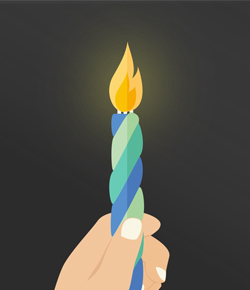 Question:I have always been fascinated by the havdalah ceremony, which marks the transition from Shabbat to the weekday. I know that we make a blessing on a special havdalah candle, but I never had the courage to ask why. What’s up with the flame?Reply:The Midrash relatesBefore the creation of the sun and moon, G‑d created a great light, a light so bright that “one could gaze from one end of the earth to the other” with it.It was very late Friday afternoon on the sixth day of creation, and Adam and Eve had just sinned by eating from the forbidden fruit. As a consequence, G‑d wished to hide this bright primordial light and expel Adam and Eve from the Garden of Eden. However, due to the sanctity of Shabbat, G‑d postponed His actions and left the light to shine until the end of the sacred day. When the sun began to set at the termination of Shabbat, darkness set in for the first time, terrifying Adam, who thought that the darkness would engulf him. G‑d then inspired Adam, who took two stones and struck them against each other, and fire burst forth. At that moment, Adam praised G‑d and said the blessing “Blessed are You, L‑rd our G‑d . . . who creates the lights of fire,”1 the very same blessing we say as part of havdalah, while gazing at the flickering flames. A Unique CreationFire is unique, for unlike all the other creations, we make a special blessing commemorating the time it was created. The reason for this is that since the use of fire is prohibited throughout Shabbat, and it becomes permitted only on Saturday night, it is as if fire is created anew each week with the departure of Shabbat.2The Practical LessonAs the holiness of Shabbat departs, and we are about to go back to our daily life, we may feel that we are no match for the raging tempests coming our way. The havdalah candle reminds us that just as Adam was able to create a flame—from stone!—that combated the swirling darkness, we too can bring light and clarity to the darkest of circumstances from the most unexpected sources.
Rabbi Yehuda Shurpin responds to questions for Chabad.org's Ask the Rabbi service.
© Copyright 2015, all rights reserved.
| ||||||
Your Questions
| ||||||

Dear Rachel,
I am worried about my seven-year-old daughter. She is a very sweet girl and has a lot going for her, but she seems very insecure. She always asks permission to do things that no one needs permission to do, and she isI am worried about my seven-year-old daughter always checking to see if she is doing the right thing. For example, she’ll ask, “Mommy, I dropped my fork. Can I pick it up?” And after I give her permission to pick it up, she’ll say something like, “That was good that I picked it up, right?” My other kids would never ask such questions—in fact, if they dropped a fork, they’d just leave it on the floor for someone else to pick up! What can I do to help my daughter become more confident? Concerned Mommy Dear Concerned, As Jews, we are cognizant of the Torah’s commandment to honor and respect our parents. But there is a big difference between being respectful and being insecure. The mitzvah of “kibud av v’aim”—honoring one’s mother and father—does require that children ask their parents for permission to do certain things. For instance, it is a mitzvah to ask permission to leave the table after a meal (as in, “May I please be excused?”). It is a mitzvah to ask permission to explain one’s behavior after being accused of a wrong-doing (as in, “May I please explain?”). It is even a mitzvah to ask permission to refrain from obeying a parent (as in, “I know you asked me to wear a sweater, but could I please not wear it, because I feel warm enough without it?”). However, all of these questions involve the relationship between the parent and child. In the first example, the child is leaving the presence of the parent. In the second, the child is explaining his behavior after being confronted by a parent. And in the third one, the parent has given an instruction to the child. Your daughter’s situation is quite different. She doesn’tYour daughter’s situation is quite different need to ask permission to function independently. If you had made a rule that no one should touch things that are on the floor, then her question would be permitted. However, in the absence of such a rule, your daughter needs to be able to behave independently. Don’t encourage dependence by answering such questions. Instead, encourage her to make her own decisions. For example: Child: “Mommy, I dropped my fork. Can I pick it up?” Parent: “That’s up to you.” Child: “I picked it up. That was good, right?” Parent: “What do you think?” The trick here is to be consistent. Children with this sort of anxious behavior tend to be persistent and even a bit tricky in their approach. They’ll ask a question one way, and if they don’t get an answer, they’ll ask it another way and then another until the parent finally gives them the answer they are looking for. For instance: Child: “Eight o’clock is bedtime,right?” Parent: “What do you think?” Child: “I think it is, but am I right?” Parent: “What do you think?” Child: “Well, I know it’s not seven o’clock. It’s not seven o’clock, right?” Parent: “What do you think?” Child: “I want to know what you think!” Parent: “I think you know all these answers.” Child: “Yes, but last night I went to bed just before eight, so can I stay up till eight tonight?” And so on. Such children are not trying to drive you crazyShe is not trying to drive you crazy (although it may seem otherwise). They are going through an anxious process. Giving up and giving in—giving them the answer they are seeking—causes this anxious process to grow stronger in the brain. Although it may seem cruel in the short run, the kindest thing you can do in the long run is to help the anxious wiring shrivel up by forcing your child to find her own truth. When she does so again and again, she will build feelings—and neural pathways—of confidence and security. Rachel
"Dear Rachel" is a bi-weekly column that is answered by a rotating group of experts. This question was answered by Sarah Chana Radcliffe. Sarah Chana Radcliffe is the author of The Fear Fix, Make Yourself at Home andRaise Your Kids without Raising Your Voice. Visit her parenting page or access her teleclasses.
© Copyright 2015, all rights reserved.
| ||||||
Earthquake in Nepal
| ||||||
When Chabad of Nepal got word that about 50 Israelis were stuck in the several remote villages with no food, electricity or water, they sprang into action, organizing an effort to try and reach them. But a rescue mission to deliver food and a satellite phone to them by motorcycle yesterday ended after a 10-hour journey that met with blocked roads and no way to get through to them.
Earlier today, they tried again. This time, Rabbi Chezky Lifshitz—co-director of Chabad of Nepal with his wife, Chani—took to the skies himself in a Nepali helicopter to reach the stranded. Since the quake first happened, Lifshitz has been communicating with many of the Israelis stuck in the mountain regions in remote areas like Dhunche and Syrabrubesi, using satellite phones fixed with GPS that the hikers are carrying. He then relays their locations to the Nepalese government. It was earlier tragedy that made the use of the satellite phones possible. The family of Nadav Shoham, a hiker killed last year in a freak blizzard, donated the phones to ensure other hikers could be reached in case of emergency. The phones are handed out to some backpackers when they leave the Chabad House so they can stay in touch and have become vital link in recent days. When the rabbi touched down in Dhunche with food and water, he found the group cold, tired and hungry. The relief was clear on their faces as they gathered up their personal belongings and backpacks. Most were eager to head back home, though the Chabad House in Kathmandu would be the next best thing in the short term. 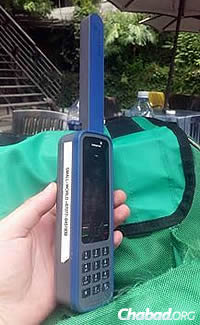
Satellite phones are often handed out to backpackers at the Chabad House so they can stay in touch. They have become a vital link in recent days. (Photos: Chabad.org/Nepal)
(While the rabbi was out rescuing the stranded, his wife Chani was serving up 2,000 meals to Nepalis back at the Chabad center in Kathmandu and his children were being hosted at the home of Israel's President Reuven Rivlin.) When Rabbi Lifshitz returned to the Chabad House at 9 p.m. this evening, he was not alone; he arrived with a group of rescued Israeli hikers in tow. “With the kindness of G‑d, they succeeded in saving 25 friends,” his wife wrote on their Facebook page. “They are weak after full days [without supplies] in the wilderness. We brought them all to the Chabad center. The crew here greeted them with tremendous emotion. They’ve now had a hot meal, and received warm clothing and supplies. They are all here for the night.” In response to the photos of the rescue operation, one woman posted: “Thank you very much for extracting from my brother and his girlfriend, there are no words to thank you for all you are doing.” Tomorrow promises to be another day, another chance to reach those desperate to get home, another chance for more families to be reunited even if it’s through photos online. To help with the earthquake relief effort, visit the special relief fund page: www.Chabad.org/Nepal. 
(Photos: Chabad.org/Nepal)
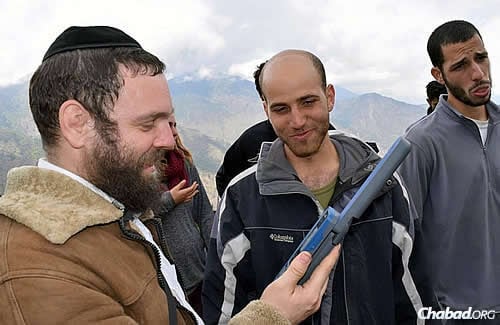
(Photos: Chabad.org/Nepal)
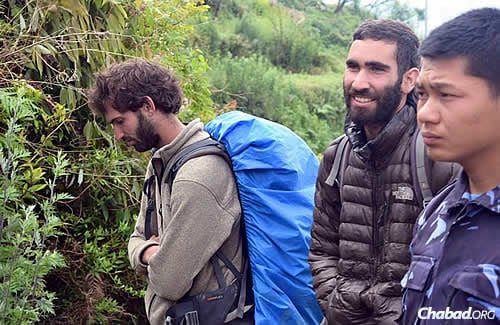
(Photos: Chabad.org/Nepal)
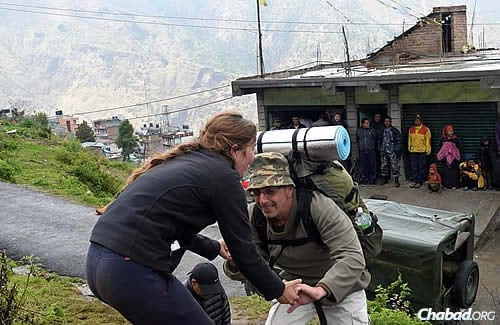
(Photos: Chabad.org/Nepal)
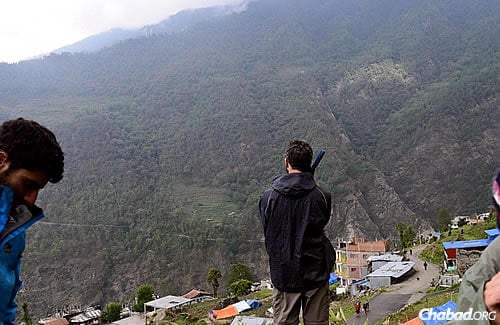
(Photos: Chabad.org/Nepal)
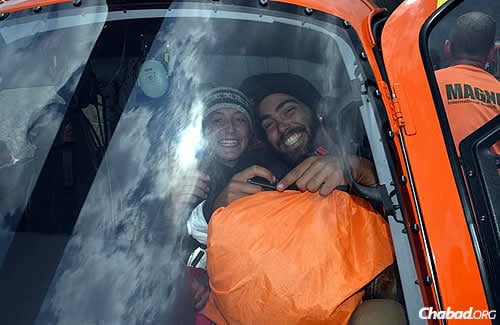
(Photos: Chabad.org/Nepal)

(Photos: Chabad.org/Nepal)

(Photos: Chabad.org/Nepal)

(Photos: Chabad.org/Nepal)

(Photos: Chabad.org/Nepal)
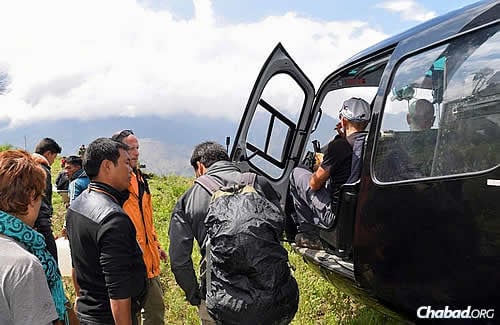
(Photos: Chabad.org/Nepal)
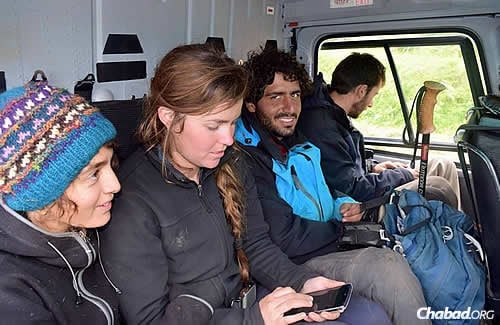
(Photos: Chabad.org/Nepal)
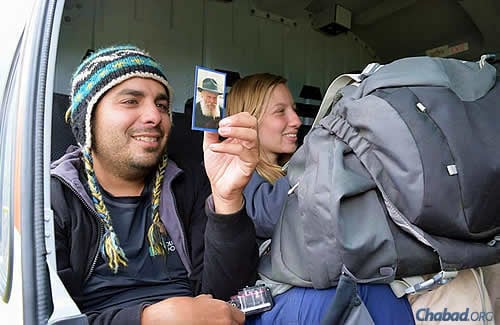
(Photos: Chabad.org/Nepal)
© Copyright 2015, all rights reserved.
| ||||||
Earthquake in Nepal
| ||||||
On the ground in the Nepali capital of Kathmandu, the urgency and desperation of those living in the region is acute—and in some places, desperate. Thousands of people have no homes to return to, no food, no water and no way to get supplies they desperately need.
It’s a situation that is repeated over and over again in Nepali towns and villages days after a massive earthquake on Saturday destroyed much of the infrastructure in a country that was already one of the poorest and least developed nations in the world. While a few stores are open, the shelves are pretty bare. Still, Chabad is able to restock on some basics like rice flour and fresh produce, according to David Karsenty, a native of Paris, who has been in Kathmandu helping Rabbi Chezky and Chani Lifshitz, co-directors of Chabad of Nepal, since just before Passover. Rabbi Yehuda Rose, who came to help with disaster relief after the quake, adds: “The ingredients are very basic, and we understand that we need to do what it takes to make sure these people have at least pita and dal bhat[a lentils-and-rice local food staple] to feed their families.” To help their neighbors, Chabad set up a food stall on Wednesday in a particularly improvised area and began handing out food to anyone who was there. Some 200 men, women and children quickly lined up for bowls of warm sustenance, which was distributed by Israeli tourists staying at the Chabad House. The sheer joy on people’s faces as they took the food was infectious, describes those close to the situation; it also gave the volunteers a feeling of accomplishment and empowerment knowing that they were helping others. “The whole time, they didn’t stop saying ‘thank you,” and ‘please, please bring more foodtomorrow,’ ” Karsenty recounts, adding that they will indeed go back tomorrow. 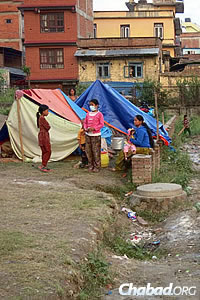
Many have no food or water, and their homes have been destroyed. (Photo: David Karsenty/Chabad of Nepal)
All of this activity comes as the Lifshitzes continue to feed the dozens and dozens of Israelis who are still making their way down from the mountains and villages, and finding respite at the Chabad House. Chabad estimates that it prepared nearly 2,000 meals on Wednesday and will make more for Thursday. They are also organizing food aid to be sent on motorcycles to outlying areas. “They come back weak, tired and very hungry,” says Chani Lifshitz on Facebook. “We are constantly bringing huge pots of food out of the kitchen. Now are spreading out sleeping bags and blankets arranging places for the few hundred [people] to sleep.” (While Chani Lifshitz was serving up 2,000 meals to Nepalis outside the Chabad House in Kathmandu, her husband, Rabbi Chezky Lifshitz, was out in a helicopter rescuing travelers, andtheir children were being hosted at the home of Israel’s President Reuven Rivlin.) To help with the earthquake relief effort, visit the special relief fund page: www.Chabad.org/Nepal. 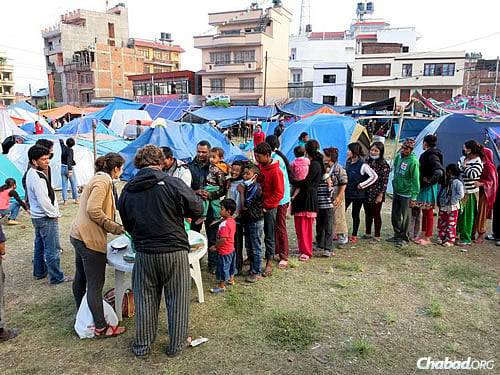
Some 200 men, women and children quickly lined up for bowls of warm sustenance, which was distributed by Israeli tourists staying at the Chabad House in Kathmandu, Nepal. (Photo: David Karsenty/Chabad of Nepal)
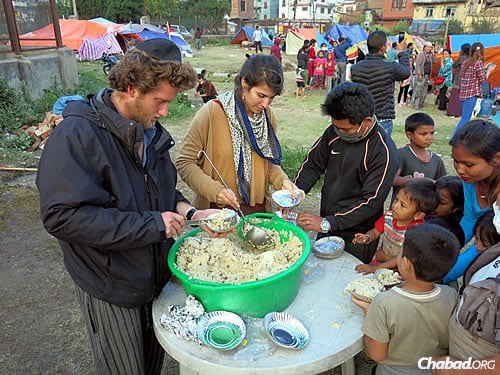
They were served a hot dish of "dal bhat," a lentils-and-rice local stapled, and pita bread. (Photo: David Karsenty/Chabad of Nepal)
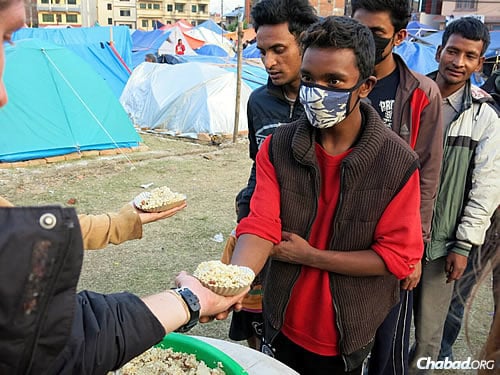
Chabad estimates that it prepared nearly 2,000 meals on Wednesday and will make even more on Thursday. (Photo: David Karsenty/Chabad of Nepal)
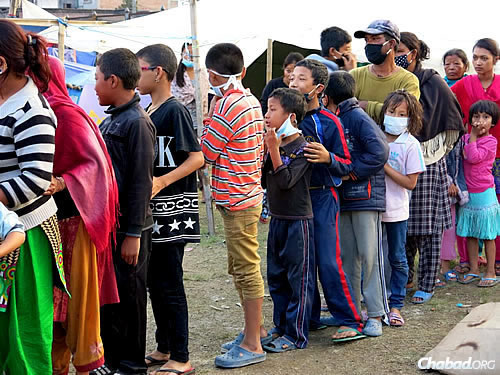
The Nepali people, many of them neighbors, expressed their gratitude for the warm food. (Photo: David Karsenty/Chabad of Nepal)
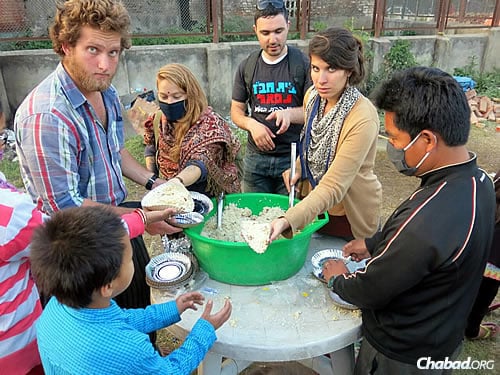
The volunteers, many of them young Israelis, felt empowered at being able to help. (Photo: David Karsenty/Chabad of Nepal)
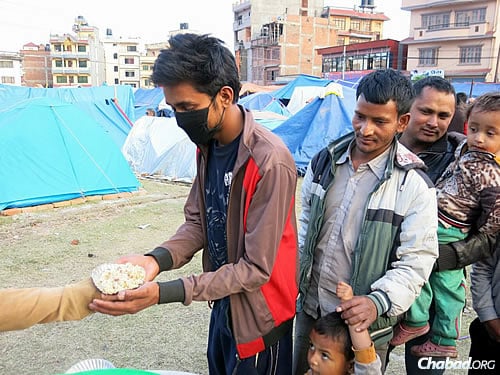
The sheer joy on people’s faces as they took the food was infectious, describes those close to the situation. (Photo: David Karsenty/Chabad of Nepal)
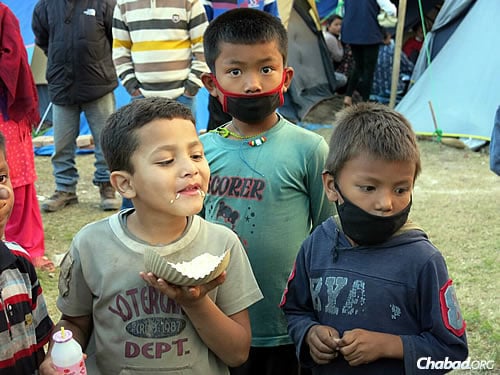
Children enjoy a meal and seem to keep up their spirits. (Photo: David Karsenty/Chabad of Nepal)
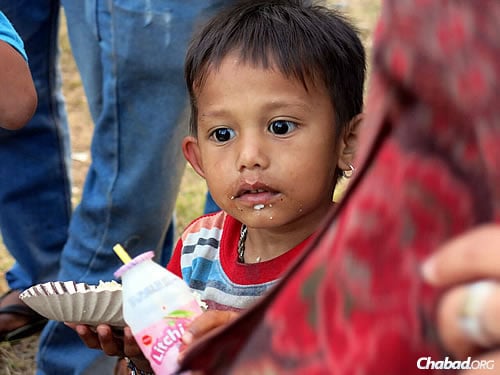
Chabad is able to restock on some basics like rice flour and fresh produce, and will continue to feed the hungry there. (Photo: David Karsenty/Chabad of Nepal)
© Copyright 2015, all rights reserved.
| ||||||
Earthquake in Nepal
| ||||||
When a group of backpackers was found Tuesday morning by search-and-rescue helicopters in a remote region of Nepal, the first public word for many desperately anxious relatives and friends appeared not in the news media, but on Chabad of Nepal’s Facebook page: “Fifty Israelis were rescued from the Langtag National Park, and they are on their way the Chabad House! We’ll post a list of names soon!” read the Facebook post in Hebrew.
The posting came soon after there were cheers of relief at the Chabad center by the more than 100 backpackers and hikers who have taken refuge there. While those discovered today have yet to be airlifted to safety, thousands of people, including 11 Israelis, remain unaccounted for. The Chabad center posted their hopes and prayers to welcome them all. In the hours—and now days—since a 7.8 magnitude earthquake shattered the Nepal capital of Kathmandu and surrounding regions, social media has become a vital link for families searching for their loved ones and for those desperate for any news coming out of the region. A prime example is the Facebook page of Chezky and Chani Lifshitz, co-directors of Chabad of Nepal, which is usually filled with family photos, visitors’ pictures, announcements about upcoming events, holiday notifications and other local tidings. Although they remain without phone service, public electricity or running water, with sparse power only from a small generator, the emissaries are able to occasionally get an Internet connection where they briefly post information and photos that serve as a lifeline for those outside the impoverished South Asian nation seeking information and assistance. The situation has also shed light on the commitment of Chabad-Lubavitch emissaries, who work with and care for not only other Jews, but humankind as a whole. 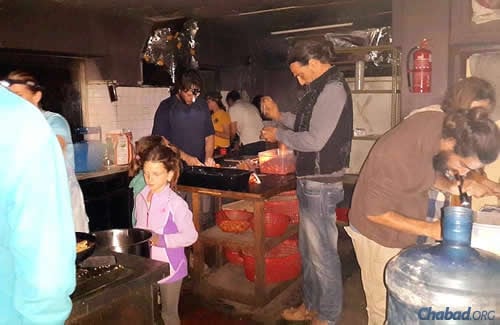
Making a meal out of scant items in the Chabad House kitchen. Food and water have been dwindling, though donations are coming into the country.
“It is 6:15 p.m.,” Chani Lifshitz wrote Monday evening on Facebook. “Hot dinner is being served right now to anyone who needs it here at Chabad in Kathmandu. From moment to moment, we are learning that establishing proper communication and discovering the scope of the tragedy that happened here will take longer than we had thought. Meantime, we are trying to give strength to worried friends and families. We promise that we will not stop for even a moment from working all avenues.” To date, more than 4,000 people have been killed as a result of the massive earthquake that struck Saturday, opening huge gaps in roads and toppling buildings throughout the region, including some ancient structures. Nepalese military are working to help with the massive search efforts underway to find people trapped in the rubble. Aftershocks have slowed and decreased in intensity, yet thousands are now homeless and living in makeshift tents or sleeping on right on the rubble. The number of dead is expected to rise as search-and-rescue teams, including several groups from Israel, arrive in Nepal and weed their way through the wreckage. 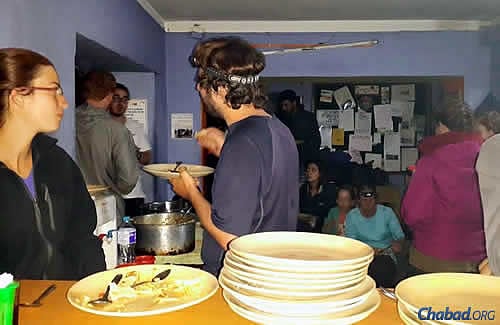
The Chabad House has served as a makeshift shelter and crisis center, especially for young Israeli travelers, since the quake struck.
Mitzvah Campaign at WorkWhile those seeing the images and destruction coming from that part of the world may feel unable to help, there are indeed things they can do from home, stresses Rabbi Sruly Simon, co-director of Chabad Student Centre of Kingston, in Ontario, Canada, with his wife, Esther. It was a mission they took personally after learning that a young man who had been involved with their Chabad House—22-year-old Casey Blustein—was missing in the quake’s aftermath. 
Casey Blustein, 22, got a hold of relatives online to let them know he was safe.
With the help anotherChabad-Lubavitch emissary—Rabbi Shmuel Kauffman, co-director of the Chabad Dorval Jewish Center in Canada with his wife, Rivka—he created a webpage with a list of mitzvahs and asked people to pledge a good deed, from reciting a prayer to giving charity. Even looking for kosher symbols on foods to purchase and eat counts. The “Mitzvah Drive for Casey Blustein” was launched late Sunday night. By mid-morning on Monday, Casey had made contact with relatives and even updated a Facebook page his family started to help find him. “Every single mitzvah helps,” says Simon. “We have an ancient tradition that physical acts, good deeds, in one place, one location, have physical effects on other location ... and creates tangible benefits whether one knows the person or not.” 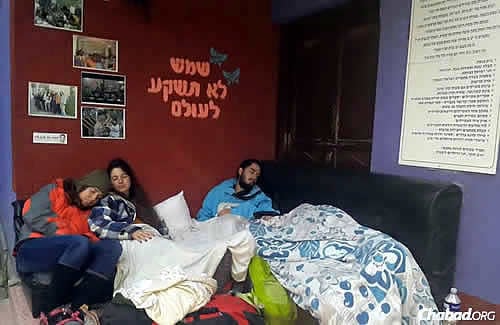
People make due at the Chabad House in Kathmandu, sleeping on couches, chairs, tables, mattresses on the floor—even outside on the ground.
They are posting pictures and notes about their loved ones in the hopes that the Lifshitzes or someone else at the Chabad House in Kathmandu may have information. Some post in Hebrew. Others link to missing posters in English or Spanish. Studying a group photo on Facebook, one woman urged the Lifshitzes to identify the people in their pictures: “We think we saw him in a photo there with you. Please let us know who is the blond boy in the photo!” Aware of how desperate families are, the Chabad couple will continue to update the list of Israelis who have been in contact with them. To help with the earthquake relief effort, visit the special relief fund page: www.Chabad.org/Nepal. 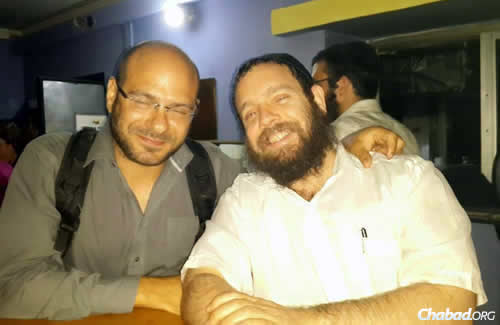
Rabbi Chezky Lifshitz, right, co-director of Chabad of Nepal, talks with a guest, trying to make the best of a difficult situation.
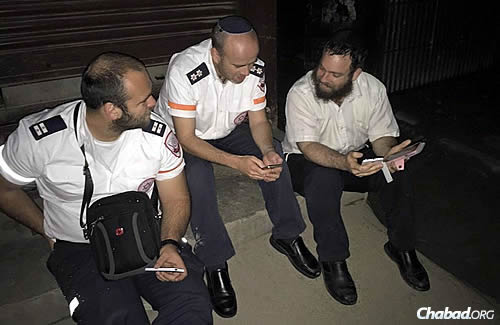
The rabbi with representatives of Magen David Adom—Israel's national emergency medical, disaster, ambulance and blood-bank service—who flew in from Israel to help.
© Copyright 2015, all rights reserved.
| ||||||
Earthquake in Nepal
| ||||||
With their parents still in Nepal—coordinating Chabad’s rescue and relief efforts in the aftermath of the recent earthquake that has killed and injured thousands of people—the three young children of Rabbi Chezky and Chani Lifshitz, co-directors of Chabad of Nepal, were airlifted to Israel today. Once there, they were greeted as guests at the home of Israel’s President Reuven Rivlin.
Four days after the 7.8 magnitude quake that struck the impoverished South Asian country on April 25, the couple decided to send their children to their home country. Shmuel, Rivki and Yitzchak Lifshitz, all under age 6, were sent with their Nepali nanny to stay with their grandparents in Israel. Meeting with the president, who greeted them with a hug and kosher chocolate, they were able to call their parents in Nepal. During the course of the conversation with Rabbi Lifshitz, Rivlin praised the humanitarian work the couple was doing there, together with their team of rabbinical students and Israeli volunteers. “What you are doing for the world, and certainly for Israelis who are [in Nepal], is remarkable. Your activity, in the Jewish, Israeli and universal spheres—and the way you opened your home to people in times of need—is amazing,” said Rivlin. “Just as you opened your home to the entire world, we have opened our home to your children here in Israel.” Rivlin assured the Lifshitzes that their children would be going to school in Israel, so as not to lose even one day of learning and Torah study. When asked by her daughter when they would be returning home, Chani Lifshitz responded to little Rivki that they would be reunited soon. “There are a lot of people we need to help,” she said to her daughter. (On the day that the children spent time with Israel’s president, their father was out in a helicopter rescuing some of the stranded in the Nepal wilderness, while their mother was serving up 2,000 meals to Nepalis at the Chabad center in Kathmandu.) In the Face of Tragedy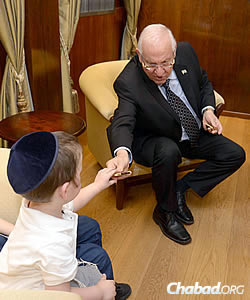
A little chocolate from the president. (Photo: Mark Neiman/GPO)
Last year the Chabad emissaries received a surprise telephone call from the Israeli Ashkenazic Chief Rabbi David Lau, who expressed his gratitude to them after helping the Israeli victims of two incidents. Lau told Rabbi Lifshitz that he was awarding him with a special certificate of honor from the Chief Rabbinate for his actions in locating and getting treatment for the wounded, and keeping their families in Israel updated about the situations. “All of the nation of Israel looks at you and your wife, and sees a couple who are ambassadors of the honor of the Jewish nation—a Jewish couple who decided to embrace in all of their lifestyle the concept of ‘all Israelites are responsible for one another,’ ” said Lau. “You are the home of Israelis throughout the year, and also in difficult days like these you are their home, their parents, siblings, doing everything for them. I have no words to express all that you are doing for every one of the Jewish people who encounters hardship,” he added. 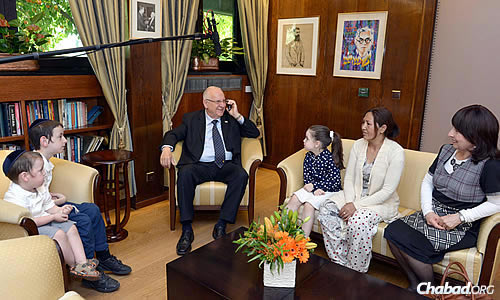
Rivlin called the Lifshitzes, assuring them that the kids were well and wouldn't miss any school. (Photo: Mark Neiman/GPO)
With the Nepali President Ram Baran Yadav estimating that as many as 10,000 people were killed as a result of Saturday’s quake, the situation remains calamitous. To help Chabad’s relief efforts: chabad.org/nepal. 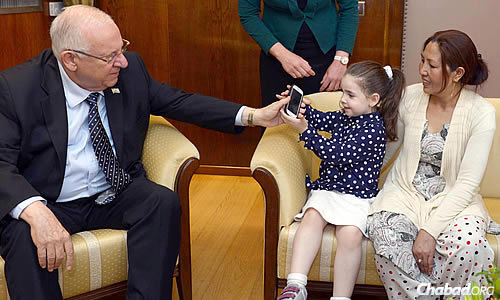
Rivki talks to her mother, who said the family would be reunited soon. (Photo: Mark Neiman/GPO)
© Copyright 2015, all rights reserved.
| ||||||
Essay
| ||||||

There are many myths about Chabad. Like the one that Chabad invented Jewish outreach. Don’t believe a word of it. Chabad never did outreach. The term is antithetical to everything that Chabad and the Rebbe stand for.
Take the case of the rabbi who wrote to the Rebbe boasting that he was involved in outreach. He used the Hebrew term kiruv rechokim, which translates as “bringing close those who are distant.” The poor rabbi must have really regretted that letter. The Rebbe wrote back indignantly: You call them “distant”?! What gives you the right to say that you are close and they are far? You must approach each one of them as though you are the King’s servant sent with a message to His most precious child!Others who spoke with the Rebbe on the subject have similarly groped and fallen. One Chabad supporter told the Rebbe about a Shabbaton he had sponsored for over forty couples who “had no Jewish background.” “No what?” the Rebbe responded, as though in shock. “No Jewish background,” was the hesitant response. “Tell them that they have a background! Their background is that they are children of Abraham, Isaac and Jacob!” the Rebbe replied. So I don’t believe that the Rebbe preached outreach, and Chabad, from what I’ve seen, doesn’t practice it. Sure, the word gets used, but there are days I think we should ban it. We don’t need any more distinctions between Jews. We certainly don’t need to divide ourselves between those who are on the inside and those who are on the outside. In Chabad, there is one Jewish people, all of us in the same inside of the same boat. So what do we practice? What is a Chabad House? What is the mitzvah campaign? What are all these beards and black hats, sheitels and long skirts doing in the most bizarre places, if not outreach? Quite simply, we are patching up the boat. In the Rebbe’s words: A Jew may say to you, “Why can’t you leave me alone? Why can’t you just go and do your thing and let me do mine? What does it bother you if I drill this little hole in my little boat?”That is and always was the theme behind the mitzvah campaign. Again, in the Rebbe’s words: The soul of the mitzvah campaign is ahavat Yisrael—love of the Jewish people. And the meaning of that love is that we are all one.That’s why there was never a campaign that was meant only for “them out there.” Every campaign encompassed and embraced the entire Jewish people. When there was a tefillin campaign, not only did we run out on the streets to roll up sleeves and apply the “Jewish blood pressure test”—we took our own tefillin to a scribe to be checked as well. When the Rebbe initiated the mezuzah campaign, he made sure to discover a cranny of his own office that could use a new mezuzah as well. When he started a campaign to have a charity box in every Jewish home, he started personally handing out dimes and dollars to children and grownups to give to charity. So, if a Chabad House is not an outreach center, what is it? Chabad is an idea. An idea that is valid no matter where you are and who you think you are. It wasn’t invented yesterday, and it’s not going away tomorrow. It is the idea that every person has to use his own mind to awaken his heart and connect with his G‑dly soul. A Chabad House is a place that facilitates that. For anybody who wants to make that connection. So why are we “out there”? Why do we make such a big deal of traveling to the furthest reaches of the world, as long as another Jew might be found there? Aren’t there enough Jews to take care of in Brooklyn and Jerusalem? Because this is the mandate given us in our time, to “spread the wellsprings to the outside.” As the Rebbe pointed out, not that the water from the wellsprings should spread to the outside. That would be outreach. The wellsprings themselves should be outside. The “outside” should become wellsprings. Every single one of us, without distinction. There’s a Jew somewhere in the world who imagines he’s “out there.” He doesn’t find in himself—if he ever stops to look for it—any connection left with his people. Maybe he’s far away on the globe, maybe further in ways of life, ways of thinking. We come to him and tell him, “Really, you are on the inside. Really, you never left. The fact that you find yourself so ‘out there’—you were guided to this place, this mindset, so that even here you would find the Torah and even here you will delight in its living water. Until you yourself will become a wellspring to this part of the world.” In Chabad, every reach reaches deeper within.
Rabbi Tzvi Freeman, a senior editor at Chabad.org, also heads our Ask The Rabbi team. He is the author of Bringing Heaven Down to Earth. To subscribe to regular updates of Rabbi Freeman's writing, visit Freeman Filessubscription.
© Copyright 2015, all rights reserved.
| ||||||
Essay
| ||||||

Our synagogue was recently ransacked. Silver ornaments for the Torah scrolls were stolen in the dark of the night, and only some were retrieved by police, albeit in ruins.
It got me thinking: Pulling off a successful burglary requires a distinct set of skills (and certain questionable moral traits). The 18th-century chassidic master Rabbi Zusha of Anipoli encountered such dubious characters during his exhaustive travels through the towns and villages of the Galicia region in Eastern Europe. Yet, true to the chassidic rule that everything one encounters can be a lesson in the service of G‑d, he examined what he saw in a different light. He prayed that thieves transfer their proficiency to an honorable cause, and taught us to do the same. Here are seven lessons in faith that Reb Zusha learned from a typical thief’s mode of action: 1. Be discreet.A thief knows to stay mute about his schemes and acquisitions. Rambling about newly acquired goods (or, in today’s terms, posting them on social media) can lead to swift arrest for the thief. Metaphorically, this can provide a lesson in terms of an honorable person’s faith. Your faith is first and foremost personal, and does not have to be broadcast to others.2. Be fearless.A criminal will go to great lengths to achieve his goal; he sometimes places himself in high-risk and life-threatening circumstances if the prize he covets seems worthy. Though a negative trait in a sociopath, fearlessness can be beautiful in the faithful. Remaining true to your faith is never a smooth sail. It should be guarded and observed even in unpromising surroundings.3. Be mindful of the details.The smallest of details is of great importance to a thief. A master plan can crumble due to an overlooked detail. Likewise, faith is much more than grand gestures. Rather, it’s defined by the daily commitment of its practice and particulars.4. Be patient.Grand larceny can be months in the planning. Perfection comes with sweat and toil. Reaching spiritual heights isn’t an overnight activity, but a lifelong journey you should not be afraid to take.5. Be eager and willing.A thief approaches each job with eagerness. Each job provides him a thrill, as he gets a chance to outsmart others and outperform himself. Your faith should be practiced with cheerful willingness, and each new opportunity for learning and garnering insight should be a thrilling accomplishment.6. Be confident and optimistic.A saying goes that the most sincere prayer is the one the thief recites before embarking on a job. A thief truly believes he will succeed with his mission and will get away with it. Pessimism and religion can’t go together. Prayer must be approached with confidence and hope.7. Always try again.If his first job was a failure (and he didn’t end up in the cell), the thief goes at it again—this time with better planning and execution. If you fail the first time, try again and again. Faith demands more from you than a single try. Give it another shot and you’ll get another chance.
Rabbi Yehuda L. Ceitlin is the outreach director of Chabad Tucson, and associate rabbi of Cong. Young Israel of Tucson. He coordinates the annual Yarchei Kallah summit of Chabad scholars, and was on the editorial staff at Chabad.org.
© Copyright 2015, all rights reserved.
| ||||||
Parshah
| ||||||

It has long been recognized that relying on fossil fuels as a power source is not sustainable in the long run. The earth’s natural resources are becoming depleted, and burning coal and gas contributes to pollution and global warming. Solar power is one of the best sources of renewable energy, especially in hot desert areas. There, the intense sunlight is a potent form of energy that in most cases merely bakes the earth but is not harnessed for productive ends.
Solar power is one of the best sources of renewable energyThe world’s largest solar power plant has recently opened in the Mojave Desert, consisting of rows upon rows of bright mirrors spread across nearly five square miles of the desert floor. The mirrors focus the desert’s intense sunlight onto boilers, which heat water into steam. The steam then turns a turbine to generate energy. The plant produces enough energy to power 144,000 homes. The site of the power plant has virtually uninterrupted sunshine all year round and is situated near power lines, making it an ideal setting for converting sunlight into usable energy. No form of energy is of any use unless there is a way to channel and harness it. Otherwise, the energy simply dissipates. We find a similar concept in Jewish thought. There are certain times of the year when special spiritual energy is generated—such as on Shabbat, holidays or Rosh Chodesh, the new moon. We must find a way to capture the energy and use it to drive our continuing development as human beings, to energize us in the fulfillment of mitzvahs. We find an example of poorly channeled energy in this week’s Torah portion, when Nadav and Avihu, the two sons of Aaron, entered the Tabernacle and brought a “strange fire” to G‑d. They were so enthusiastic about the building of the Mishkan and the prospect of becoming close to G‑d that they offered a sacrifice at a time that was not appropriate for them. As a result, their souls simply flew out of their bodies in an effort to cleave to G-d. Had they not been so overeager, they could have used this intense spiritual power to bring about real change and elevation in the world. However, their spiritual zeal was focused only on rising to G‑d but not on channeling the energy here on earth. Therefore, they did not survive. We must find a way to capture the energyOver the course of exile, we have been charged with the task of building “mirrors in the desert,” harnessing the intense divine radiation that is beaming down upon us. The “mirrors” are our mitzvahs, and the “sunlight” is the divine light that is drawn down to the world through our actions. When Moshiach comes, the construction project will be complete, and we will be able to derive the full benefit of the work we have done over so many generations. Then, G‑d will “take the sun out of its shield” and the night will shine like the day.
Chaya Shuchat is the author of A Diamond a Day, an adaptation of the chassidic classic Hayom Yom for children, as well as many articles on the interface between Chassidism and contemporary life. She is a
© Copyright 2015, all rights reserved.
| ||||||
Parshah
| ||||||

There was once a man who had twenty-four thousand disciples. He taught them to love, but their love was too absolute, too true, to be loving. They died, and their death spawned a period of mourning that darkens our calendar to this very day.
This man had one disciple who devoted his entire life -- literally his every minute -- to the pursuit of truth. Yet his truth was true enough to love. He, too, passed from this world, and the anniversary of his passing is celebrated as a day of joy and festivity to this very day. This, in a word, is the story of Lag BaOmer -- the story of Rabbi Akiva and his greatest disciple, Rabbi Shimon bar Yochai. The 18th of Iyar is Lag BaOmer -- the 33rd day of the Omer Count which spans the seven weeks from Passover to Shavuot. Two joyous occasions are associated with this day. During the Omer period we mourn the deaths of 24,000 students of Rabbi Akiva who died in a plague because, as the Talmud informs us, "They did not conduct themselves with respect for each other"; Lag BaOmer is the day on which the plague ended and the dying ceased. Lag BaOmer is also the anniversary of the passing of Rabbi Akiva's greatest disciple, Rabbi Shimon bar Yochai. Before his death (many years later, without connection to the plague), Rabbi Shimon referred to the day of his passing as "the day of my happiness" and instructed his disciples that it be observed each year as a day of joyous celebration. Why is the passing of Rabbi Akiva's other disciples mourned as a national tragedy, while the passing of Rabbi Shimon bar Yochai is remembered with celebration and joy? Indeed, the very same day that celebrates the end of the dying of Rabbi Akiva's disciples, celebrates the death of his greatest disciple! To unravel the paradox of Lag BaOmer, we must first examine the root of the disrespect that caused the plague amongst Rabbi Akiva's disciples. Rabbi Akiva taught that "Love your fellow as yourself is a cardinal principle in Torah"; indeed, this is the most famous of his teachings. One would therefore expect that Rabbi Akivas disciples would be the foremost exemplars of this principle. How was it that they, of all people, were deficient in this area? But their very diligence in fulfilling the precept "Love your fellow as yourself" was their undoing. Our sages have said that "Just as every person's face differs from the faces of his fellows, so, too, every person's mind differs from the minds of his fellows." When the twenty-four-thousand disciples of Rabbi Akiva studied their master's teachings, the result was twenty-four-thousand nuances of understanding, as the same concepts were assimilated by twenty-four-thousand minds -- each unique and distinct from its 23,999 fellows. Had Rabbi Akiva's students loved each other less, this would have been a matter of minor concern; but because each disciple loved his fellows as he loved himself, he felt compelled to correct their erroneous thinking and behavior, and to enlighten them as to the true meaning of their master's words. For the same reason, they found themselves incapable of expressing a hypocritical respect for each others' views when they sincerely believed that the others' understanding was lacking, even in the slightest degree. The greater a person is, the higher are the standards by which he is judged; in the words of our sages, "With the righteous, G-d is exacting to a hairsbreadth." Thus, what for people of our caliber would be considered a minor failing had such a devastating effect upon the disciples of Rabbi Akiva. But there was one disciple of Rabbi Akiva who learned to overcome the pitfalls of uncompromising love and uncompromising truth, as exemplified by the following incident in the life of Rabbi Shimon bar Yochai: The Talmud relates that when the Roman rulers of the Holy Land placed a price on the heads of Rabbi Shimon and his son Rabbi Elazar, they hid in a cave for twelve years. During this time, they spent every minute of their day studying Torah. When they emerged from the cave, they were shocked to discover people plowing and sowing: how could people set aside the eternal life that is Torah and occupy their days with the transitory life of the material? So intense was their wrath at such folly that whatever met with their burning glance went up in flames. Proclaimed a voice from heaven: "Have you come out to destroy My world? Return to your cave!" Rabbi Shimon's thirteenth year of study, while increasing his knowledge and appreciation of the truth of Torah, also taught him the value of endeavors other than his own. Now, wherever he went, his look would heal rather than destroy. The 4,000-year history of Jewish learning has known many great and diligent students of Torah; yet none epitomized the absolute devotion to the pursuit of the divine truth to the extent exemplified by Rabbi Shimon bar Yochai. Throughout the writings of our sages, his example is cited as the ultimate case of torato um'nato, "one whose study of Torah is his sole vocation." Certainly, then, Rabbi Shimon's commitment to truth was no less absolute than that of Rabbi Akiva's other disciples. Yet his truth was true enough to love. In his thirteenth year in the cave, he attained a dimension of the divine truth that tolerates, indeed embraces, the many and diverse avenues of connection to G-d which the Creator has provided to a humanity whose minds, characters and temperaments are as diverse as their number. In his thirteenth year in the cave, Rabbi Shimon attained a level of truth in which he could utterly devote himself to the eternal life that is Torah, and advocate such devotion for everyone else, and at the same time appreciate and respect the path of those who serve G-d via the temporal life of material endeavors. So the very same day that celebrates the end of the plague amongst Rabbi Akiva's disciples also celebrates the passing of Rabbi Shimon bar Yochai. The Chassidic masters explain that the passing of a righteous person marks the point at which "all his deeds, teachings and works" attain the pinnacle of fulfillment and realization and the point of their most powerful influence upon our lives. And the deeds, teaching and works of Rabbi Shimon bar Yochai are the ultimate rectification of Rabbi Akiva's disciples' tragic failure to achieve the proper synthesis of love and truth that would make their love true and their truth loving. As noted above, it is only among men of the caliber of Rabbi Akiva's disciples that such a failing could bode such devastating results. But our sages chose to record this story for posterity and fix it in our lives with a series of laws that govern our behavior in the weeks between Passover and Shavuot each year. Obviously, we, too, have something to learn from what happened to Rabbi Akiva's disciples. The lesson is twofold: we must learn from their virtues as well as from their mistakes. We must learn to care enough for our fellow man not to indulge his errors and accommodate his failings. This might be the easiest and most socially comfortable way to behave, but, rather than tolerance, it bespeaks an indifference toward his or her welfare. On the other hand, we must never allow our commitment to his betterment to lessen in the slightest our respect and esteem toward him, no matter how misguided and unresponsive he might be. If this seems paradoxical, it is. But the ability to embrace this paradox is at the very heart of the Torah's commandment to "Love your fellow as yourself." For in regard to ourselves, it is a paradox with which we are quite comfortable -- every psychologically healthy person loves himself unconditionally and, at the same time, incessantly strives to improve himself. This paradox we must also cultivate in our relationship with others: on the one hand, we must never compromise our efforts to improve our fellow man out of respect for his views and feelings; on the other hand, we must never allow these efforts to compromise our love and respect for him. For to succumb to either compromise is to fail to love him as we love ourselves -- a principle which Rabbi Akiva considered fundamental to G-d's blueprint for life and of which Hillel said: "This is the entire Torah; the rest is commentary."
Based on the teachings of the Lubavitcher Rebbe, Rabbi Menachem Mendel Schneerson; adapted by Yanki Tauber.
Originally published in Week in Review.
Republished with the permission of MeaningfulLife.com. If you wish to republish this article in a periodical, book, or website, please email permissions@meaningfullife.com.
© Copyright 2015, all rights reserved.
| ||||||
Women
| ||||||

“You mean you don’t touch boys at all?” my niece Tracy exclaimed.
“Nope,” my daughter Sarah responded. “Not ever.” I was in the kitchen chopping salad vegetables when I overheard this snippet of conversation between my 17-year-old daughter and my 16-year-old niece, who was visiting us in Israel from New Jersey. I set down my chopping knife, moved closer to the kitchen door, and began to prepare a potato salad. I wondered what had precipitated this conversation. "Do you like boys?"“Gosh,” Tracy said after a pause. “Do you like boys?” “Of course I do!” Sarah laughed. “I just don’t touch them. I’m what we call shomer negiah—which mean I follow the rules that forbid touching men or boys not in my family.” “I never even heard of that!” Tracy answered. “That seems so weird.” “Well, when you’re used to it, it’s not weird at all. I feel like these rules really protect me.” There was a pause in the girls’ conversation. “Well, what if a guy just wants to ‘high five’ you?” Tracy asked. “Is that considered touching?” “I’ll throw it back at you,” Sarah replied. “What do you think?” “Well . . . of course it is touching, but it’s just innocent.” “Is it?” Sarah asked. “Always?” “Well,” Tracy answered, “I guess sometimes yes, and sometimes no.” “So,” Sarah responded, “I never even have to analyze—is it innocent or is it a come on? Do I say okay to one guy’s high five and no to another’s? I’m off the hook. I’m safe!” “But hey, what if there’s a guy you like? You’d want to give him a high five, or just hold hands, wouldn’t you?” “Well, I’d feel like I wanted to, but I wouldn’t do it. Just imagine, if you wait until you’re married to touch a guy, think of how special that first kiss will be. You won’t be comparing your husband to anyone. It’s so romantic.” “Well,” Tracy replied, “It sounds romantic, but not really practical. I mean, have you ever had a boyfriend?” “Well,” Sarah answered, “I did meet a boy I liked, but I wouldn’t call him a ‘boyfriend.’”"Have you ever had a boyfriend?" Our family is Orthodox but a bit "modern," and it is not uncommon for boys and girls in our community to develop friendships with each other, although in communities that are more careful, that too would not be appropriate. “Well,” Tracy continued, “didn’t he want to touch you?” Here Sarah paused. “Well, he did like me, so I guess he felt like touching me, but he was shomer too.” “Really?” Tracy responded, surprise in her voice. “So what happened?” “We liked each other, and it was a good feeling. We talked about it. But we both realized that we weren’t ready for a serious relationship, so we decided to just be friends. His family moved, so we don’t see each other too often, but we’re still in touch.” I knew the young man Sarah was describing. Sarah had confided to me about him during a late-night chat over hot chocolate and popcorn. Although Sarah knows I don’t want her to be involved in a romantic relationship before she’s ready to commit to marriage, I was pleased that she felt she could come to me to talk about her relationship with this young man. I was proud of her for sticking to her principles and keeping shomer even though she had feelings for him. We talked about the pressures women and girls feel to act and dress in ways that aren’t always comfortable for them. Sarah initially argued with me about the laws of modesty, which sometimes feel restrictive. But, in the end, she admitted that, especially for girls who have trouble standing up for themselves, these laws do help keep girls from getting pulled into relationships they may not want, or may not be ready for. TheI sorta wish I had those rules doorbell rang, and Sarah told Tracy that the younger kids were expected home. I heard Sarah’s footsteps as she headed toward the door. “Hey,” Tracy said before Sarah reached the door, “I just want to tell you that you’re really lucky. I sorta wish I had those rules to back me up.” “You don’t have to be religious to stick up for yourself,” Sara answered. “Try it.” As the door opened, I heard Tracy’s answer. “Awesome. I think I will!”
© Copyright 2015, all rights reserved.
| ||||||
Women
| ||||||
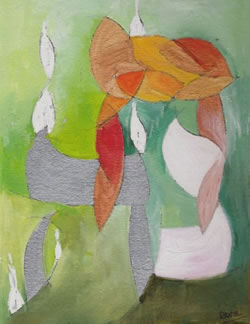
This year marks the 50th yahrtzeit of the Rebbe’s mother, Rebbetzin Chana Schneerson, of righteous memory. Recently, Rebbetzin Chana’s personal diaries were discovered, in which she recounts in great detail and with vivid description her experiences in Russia. Her purpose in writing the memoirs was that the greatness of her righteous husband, Rabbi Levi Yitzchak Schneerson, be known, and indeed, because of her writings, we are privileged to get a closer glimpse of his greatness and the tremendous impact he had on thousands of Jews. But while her intentions were focused on her husband, her diaries inevitably reveal what a remarkable and righteous woman she was, a woman deserving of King Solomon’s praises of a “Woman of Valor.”
InRebbetzin Chana’s personal diaries were discovered 1907, when her husband became the rabbi of Yekatrinoslav, she became a leader in her own right. Her home became the center of all communal activities. With the outbreak of World War I, there was a massive influx of Jewish refugees who poured into their city. She took a pivotal role in organizing the immediate absorption and integration of these refugees, as well as procuring vital relief aid. (Her son, who would later become the Rebbe, recalled that although he was young at the time, his mother’s utter devotion, care and round-the-clock efforts in helping these Jews left an indelible impression on him for the rest of his life.) She was extremely proud of her husband’s steadfastness and self-sacrifice in strengthening Judaism, and supported him wholeheartedly in every way she could, despite the high risks involved. She and her husband, as well as all their visitors and congregants, were under constant surveillance by the Russian authorities. Everyone knew they could be arrested at any given time just for associating with Rabbi Levi Yitzchak. Her most harrowing experience began March 28th, 1939, at 3 a.m. Rabbi Levi Yitzchak was arrested by four agents of the NKVD, following his high-profile involvement in facilitating the production and distribution of kosher-for-Passover matzah, building a mikvah, and other Jewish activities. For months on end, Rebbetzin Chana tried locating him and met with all levels of government officials to try securing his freedom. She tried everything she could to get her husband kosher food and medical attention, even tracking down the relatives of personnel who worked in various prisons. Often, even after substantial bribes, she was lied to and sent on false leads. After her husband had been imprisoned, tortured and interrogated for nearly a year, Rebbetzin Chana was informed that he had been tried in Moscow for his “criminal activity” and sentenced to five years of exile in the far-flung village of Chi’ili in Central Asia. There he would be completely isolated from other Jews. He was 61 and, after his horrendous prison experiences, his health was in such a dreadful state that he was nearly unrecognizable. Rebbetzin Chana, then 59, could have stayed home and tried her best to get food sent to her husband. Instead, she decided to go into exile to be with her husband and support him, no matter what that entailed. Upon arrival, she realized just how dismal the situation was. She arrived early spring, “when the ground turns into deep mud, making it difficult to walk in the street. But to obtain life’s most basic necessities, it was necessary to walk a long distance, although it was virtually impossible to get out of the quagmire. When you put your foot down, it became bogged down in the sticky morass, and you needed the strength of Samson for every step you took.” The moisture and warmer weather brought swarms of fleas, mosquitoes and other biting insects. Clothing would become covered in black dots within hours, soiled by the fleas. Rebbetzin Chana burned a type of fuel made from mud, dried-out grass and straw she had gathered, which didn’t provide light or fire, but a thick black smoke to keep the insects away. Often, the strong night winds blew that awful smoke in their faces. Every season was extreme. Summer brought unbearable heat that forced everyone indoors for cover, and winters were beyond frigid. It wasn’t uncommon for people to freeze to death. Rebbetzin Chana gathered assorted types of “bricks” and fashioned a crude furnace to help keep warm. Rebbetzin Chana and her husband moved to a few different shacks while in exile, each place with its own challenges. The shacks were made of clay, with muddy floors, and were often darkened by swarms of mosquitoes. They were damp, moist and small, often without dividing doors between the rooms, offering no privacy. Bigger shacks with the luxury of a wooden floor meant more people with whom to share the space. In one place, they had only roach-infested cots to sleep on. It was forbidden to purchase food; everything was government regulated with ration cards and quotas, requiring long daily treks and endless lines. Throughout their years in exile, the Rebbetzin and her husband suffered severe hunger, at one point going without any bread for a month! Their health deteriorated, and Rabbi Levi Yitzchak became extremely weak and frail. Everything was government regulated with ration cards and quotasThese were the conditions of exile. Yet Rebbetzin Chana was there to take care of her husband and keep up his spirits. It was due to her resourcefulness and determination that she was able to get food whenever possible and physically care for her husband, literally saving his life. She knew that more than bread for survival, he urgently needed materials to write down his copious thoughts of Torah and Kabbalah. She was determined to obtain such supplies. She taught herself how to make ink from various herbs and grasses, and presented her homemade ink to her overjoyed husband. He wrote along the margins of the few holy books and notebooks she had brought him. When Passover neared, she spent days traveling to find a utensil for Passover, knowing Rabbi Levi Yitzhak would not eat otherwise. She successfully obtained a tin-plated pail made from new materials. Once, to their surprise and joy, they received a package with white flour, and she set some aside to make two hamentaschen for the holiday of Purim. Rebbetzin Chana expressed how important and meaningful it was for them to be able to observe even a minor custom. She exerted tremendous effort to enable her and her husband to celebrate any and every observance. The effects of WWII reached Chi’ili, and an influx of evacuees arrived in their region, including a large number of Jews. Rebbetzin Chana and her husband became the natural place everyone turned to for help, inspiration and guidance. Their very presence was a lighthouse of hope and an oasis of comfort for the Jews. Rabbi Levi Yitzchak put himself in grave danger, facilitating proper Jewish burials and religious services. Despite their infirmity, they mustered every ounce of strength to lead and assist the Jews with warmth, kindness and joy. In 1944, after five years of terrible exile, they miraculously obtained Rabbi Levi Yitzchak’s freedom and moved to the city of Alma Ata. There again, undeterred, with the last of his waning strength, Rabbi Levi Yitzchak continued his efforts to strengthen Judaism, with his wife’s full support. He spent his last weeks and final days surrounded by Jews who longed to be in his presence and who thirsted for his words of Torah. Rebbetzin Chana cared for him until the very end, taking great pride in the honor and love bestowed on her righteous husband. After Rebbetzin Chana’s passing in 1964, the Rebbe commemorated his mother’s yahrtzeit with a farbrengen (chassidic gathering). At one of these farbrengens, the Rebbe mentioned that three of the mitzvah campaigns he had inaugurated corresponded to the three letters of the Rebbetzin’s name, Chana. The Rebbe explained that each letter of her name stood for one of the three special mitzvahs gifted and entrusted to women. The chet is for the mitzvah of challah, separating a portion of dough and dedicating it to G‑d. (Under the umbrella of this mitzvah is the observance of kosher.) The nun stands for niddah, the mitzvah of family purity. Lastly, the hey is forhadlakat neirot, the mitzvah of lighting candles in honor of Shabbat and holidays. The Rebbe expounded on the meaning of these three mitzvahs in numerous chassidic discourses. The Rebbe also mentioned that the greatest thing a soul yearns for, even in the highest realms of heaven, is to serve G‑d specifically in this physical world. When we dedicate a session of Torah learning or do a mitzvah for the soul, we literally connect that soul with our deed and make it a partner with us in serving G‑d in this world. It is therefore most fitting to dedicate the study of the following insights to Rebbetzin Chana, who dedicated her life to the continuation and vibrancy of Judaism. Challah: Separating a Portion of DoughWhen Friday would come around, and there were no Shabbat candles, or when it was often necessary to queue up on line until quite late before Shabbat to receive “the bread of suffering” to use for the “double loaves of bread” (challah) . . . As I left home to go to the bread line, he would say to me emotionally, “G‑d has given us a fragrant spice called Shabbat—we need to prepare ourselves for the Shabbat!”When the Jews entered the land of Israel, they were commanded to take a portion of their dough and give it to the Kohen (priest) before being permitted to use the remainder of the dough to bake their bread. This separated portion was called “challah” and considered consecrated. Today, while in exile, we observe this mitzvah through separating a small portion of dough and burning it. Our weekly loaves of bread prepared for Shabbat are affectionately called “challah” for this mitzvah performed with the dough. Bread represents our sustenanceBread is a staple food and represents our sustenance. Setting aside a portion of the dough and dedicating it to G‑d is an affirmation that everything we have comes from G‑d. It is not “my strength and the power of my hands [that] have produced this wealth for me”; rather, “it is He who is giving [me] the strength to make wealth.”1 The fact that we must separate thechallah before we can use the rest of the dough demonstrates that serving G‑d comes first and is the top priority in our lives. When we habituate ourselves to putting G‑d first, this perspective translates into us utilizing all our G‑d-given gifts in a meaningful and purposeful manner. The separated portion called “challah” contains a message within its spelling. The word can be divided into two parts, “chol-hey.” “Chol” means “mundane,” and ‘’hey’’ is the letter that represents G‑d’s name. Challah’s very name reminds us to serve G‑d in all our ways—even the mundane aspects of our lives should be infused with an awareness of G‑d. When the Jews entered the land of Israel, there were different measurement requirements given for the separated portion, based on whether the individual was a private or commercial baker. The fact that Jewish law has nuanced measurements based on the individual teaches us that matters of faith and belief (represented by the challah) are a very personal and important quest. Just as the challah is a portion of a staple food, which is digested and becomes a part of the person, our faith and belief must be something that becomes integral to us. To accomplish this, we each have to learn about our faith, processing it until it is ours. And then we need to continue onward with our journey of faith, expanding our understanding further and further. This mitzvah was given especially to women because it is women who best demonstrate how the physical world can be incorporated and elevated in the service of G‑d. It is women who feed faith to their children from a young age, and inculcate them with an understanding and appreciation for Judaism. It is women who teach their children, through example, how to spend their time and resources in service of G‑d. It is women who create the hands-on Jewish atmosphere of the home, buying or preparing kosher food, organizing the celebration of holidays, and in so many other ways. It is therefore women who perform the mitzvah of separating the challah portion, which demonstrates how G‑d is foremost in our consciousness and expressed in our everyday activities. The very act of eating, when done with kosher food and with the intent to use the energy to serve G‑d, is a most holy service. Niddah: The Laws of Family Purity“Of what crime has my husband been accused?” I asked.“He built a ‘meeka’ (i.e., a mikvah) in the courtyard of the synagogue—this is what he is being accused of. The shamas (beadle) had divulged some information about him . . . under duress.” Family purity is regarded as one of the most treasured mitzvahs, ranked in importance alongside circumcision and fasting on Yom Kippur. At the core of this mitzvah, a woman brings G‑d into her marriage and most personal experiences, expressing the idea that G‑d is a part of every aspect of our lives. The laws of family purity address the spiritual state of impurity brought about by menstruation and the great spiritual elevation that results from immersing in a mikvah. While a woman is in this spiritually impure state and for an additional seven days, until a woman emerges from a mikvah on the seventh night, a husband and wife are not permitted to be physically intimate, and they avoid physical contact with each other. Following the woman’s immersion in the mikvah, intimacy between husband and wife is considered a mitzvah, a most sacred and blessed union. Chassidism discusses the symbolism of menstruationThe laws of purity and impurity belong to a category of mitzvahs known as chukim, divine decrees, for which no reason is given. These are not physical but completely spiritual concepts, not logically comprehensible. Therefore, they are frequently misunderstood and associated with notions and myths foreign to Judaism. Chassidic thought enables us to understand the spiritual dimension, giving us an appreciation for the inner meaning and significance of the mitzvahs. It reveals the spiritual source and makeup of everything that exists in this physical world. Chassidism discusses the symbolism of menstruation and why it renders a woman spiritually impure. Blood provides the body with the nutrients it needs and is the body’s life force. It gives the body its vitality, warmth and vigor. The color red represents passion and fervor. Similarly, blood represents our natural force of attraction and enjoyment for the physical and material. This natural drive is what propels us to engage and be successful in the world; in balance, it is healthy and beneficial. However, if unguided, this natural drive intensifies and becomes excessive and out of proportion, leading to one becoming consumed with materialism. Consequently, one would become insensitive and apathetic to spiritual matters. Menstruation occurs when there’s excess blood, more than is currently necessary, and so the healthy body expels it. Thus, the excess of (menstrual) blood manifests as spiritual impurity. The mitzvah of family purity, which revolves around menstruation—symbolizing the process by which our body regulates our natural inclination toward materialism—is therefore entrusted to women, who are privileged with a greater role in serving G‑d through elevating the physical world. The concept of impurity is most associated with death. A person becomes ritually impure when he or she comes in contact with death directly or even remotely. Even being in the same building as a corpse or attending a funeral (which is a mitzvah!) makes a person spiritually impure. The Hebrew word for impurity, “tumah,” is related to the word “atum,” which means “blocked.” One way of understanding the association with death and impurity is by considering what death represents. When a person is alive, it is apparent that there is a life force, a soul, a part of G‑d that animates the person. It is easy to recognize in the living that there is a soul—G‑d’s presence can be sensed. However, when someone observes a corpse, there’s no obvious indication that leads a person to sense G‑d’s presence. Although everything in this world requires G‑d’s direct constant creative energies to exist, with a corpse, G‑dliness is concealed. To encounter death is to encounter a concealment of G‑d. There’s a blockage, some type of obstruction that interferes with the revelation of G‑d’s presence. When a woman menstruates, it indicates that a potential opportunity for life has been lost, a subtle whisper of death. So when a woman experiences the loss of blood from her uterus, associated with this loss of life, she enters a state of impurity—for she has encountered a concealment of G‑d. What is the significance of going through this process of impurity to purity? What does it achieve? G‑d created the woman with this natural cycle, which can be compared to the cycle of the week. Six days of work are followed by Shabbat, the holy day of rest. On Shabbat, one is spirituality elevated and more sensitive to the Divine, yet once Shabbat concludes, one returns to worldly engagement, a seemingly spiritual low. Each week, a person works toward Shabbat. The more effort put into preparing for the holy day, the more of a rewarding experience it becomes. Each Shabbat becomes a new opportunity for an even greater spiritual experience. Its effect spills over to the rest of the week, enabling us to elevate our most mundane work to a spiritual service of G‑d. As chassidism teaches, “Every descent is for the purpose of a greater ascent.” The process of constant renewal affords us the means to reach deep and achieve even greater heights. A woman is given the mitzvah of mikvah, which represents the epitome of transformation and self-actualization. She is given the gift of continuously heightened spiritual elevations, offering her expanded divine awareness that enables her to infuse every part of her life, her relationships and her home with divinity. The purpose of mikvah is to achieve a profound spiritual elevation. When a person immerses, the whole body is submerged in water. Water is a symbol of life; no living thing can exist without water. When a woman immerses her whole body, she is connecting to the source of life, G‑d. With this awareness, she devotes everything she has to G‑d—mind, body and soul. As a baby emerges at birth from a sac of amniotic fluid, a woman emerges from the waters of the mikvah with a sense of renewal, a freshNo living thing can exist without water beginning to her divine service with a profound divine consciousness. Her state of impurity symbolizes dealing with challenges resulting from the concealment of G‑d’s presence and our natural pull towards materialism. The mikvah experience aligns her perspective, heightens her awareness of G‑d, and strengthens her ability to channel her natural tendencies in the most productive and meaningful way. She is in an elevated spiritual state and is then prepared for the mitzvah that follows, intimacy. Intimacy is not regarded as a human indulgence but as a most sacred union that generates souls. Intimacy enables human beings to mirror G‑d as creators, to express an aspect of infinity in this world. There's no greater achievement man can accomplish than creating a human being! Hadlakat Neirot: Lighting Shabbat and Holiday CandlesWith a concerted effort, I tried to create a festive spirit, as befitting the approaching Yom Tov.. . We were reminded that we could be concerned with loftier concepts—not just with thinking about our daily bread, and drawing the pail of water from the well and hauling it through the mud . . . One of the obvious things we observe about light is that its very presence is indicative of the presence of its source. If we see light, we know there must be a light bulb, a flame, the sun or some other source from where the light emanates. Additionally, the presence of even a little light illuminates its surroundings to a much greater degree. Lighting a candle in a dark room brings enough clarity of vision to navigate safely within it. So too, performing the mitzvah of lighting candles on the eve of Shabbat and holidays immediately heightens our awareness of our source, G‑d, the creator of the world, who has given us Shabbat and holidays. The moment the candles are lit, we have ushered in the holy day, and immediately our homes are aglow with the spirit and sense of Shabbat (or holiday). With that kindled flame, our homes don’t feel like they do the rest of the week; an entirely new atmosphere has set in. Every member of the household sees the candles have been lit and knows Shabbat has arrived. It affects us completely. The activities and work we engaged in all week are out of sight and out of mind. We dress elegantly, pray, sing and eat specially prepared festive meals, enhanced with stimulating Torah teachings, inspirational stories and togetherness. It is our time of reflection and study, where we turn inward and appreciate our relationship with G‑d, recognizing G‑d’s complete involvement in every aspect of our lives and our dependence on Him. It is with this focus and perspective that we can properly navigate the rest of the week, maintaining that clarity of vision so that we sense G‑d’s presence and realize the divine providence in everything we encounter. Women are entrusted with the awesome responsibility of making their homes like “mini Temples,” doing their utmost to ensure that the next generation of Jews will be fortified with a rich appreciation of our heritage, a growing personal relationship with G‑d, and a passionate love for the Torah and mitzvahs. Since the home is most central to Judaism, where the majority of all observance takes place, and the primary realm of the woman, it is she who is honored with the mitzvah of lighting the candles, ushering into her home the holiness of Shabbat and holidays, whose illumination radiates to the rest of the week. A mother begins transmitting Judaism to her children from infancy. She teaches her daughter to perform the mitzvah of candle-lighting from the age of three, when she can confidently recite the blessing and observe how she contributes by adding her own spiritual light. Thus, the mitzvah of lighting candles exemplifies the profound scope of divine awareness generated and actualized by a seemingly simple commandment. These three mitzvahs especially given to women all present auspicious times of prayer. When lighting Shabbat and holiday candles, when separating the portion of dough, and when immersing in a mikvah, a woman uses these special opportunities to pray. The tremendous merit generated with the observance of these essential mitzvahs brings infinite blessings to the women who practice them. These mitzvahs encourage women to dig deepAll these mitzvahs encourage women to dig deep, expand their awareness and discover the powerful and essential bond they have with G‑d. With this ever-growing awareness, they infuse their homes with their beliefs and faith, and raise a nation of Jews committed to serving G‑d. They have the Torah engraved within them, expressed in their passionate observance of mitzvahs and their tireless efforts to transform this world into a dwelling place for G‑d. In the merit of the righteous women we were redeemed from Egypt, and it will be in the merit of the righteous women that we will be redeemed from this final exile. May we be inspired by Rebbetzin Chana to be meticulous in observing and internalizing the messages of these three essential mitzvahs, and thereby merit bringing the ultimate redemption. This essay is also dedicated to my mother, Rebbetzin Tzivia Miriam Gurary, OBM, on the occasion of her ninth yahrtzeit. My mother taught us and so many women about these cherished mitzvahs. She observed them scrupulously, and lived their messages. Her commitment inspires us today.
Esther and her husband are Chabad emissaries in Chautauqua, N.Y., where they work with the Jewish community. Esther, an educator for more than a decade, also teaches young women at the Institute for Higher Jewish Learning. She is the proud
Artwork by ClaudiaRavel.
© Copyright 2015, all rights reserved.
| ||||||
VIDEO
The Mitzvah to Love
The more you know someone the more you see his or her flaws. So why is loving our fellow so integral?
By Shifra Sharfstein
 Watch (50:46)
Watch (50:46)<script language="javascript" type="text/javascript" src="http://embed.chabad.org/multimedia/mediaplayer/embedded/embed.js.asp?aid=2855994&width=auto&height=auto"></script><span style="clear:both;" class="lb" id="lbdiv">Visit <a href="http://www.chabad.org/multimedia/default_cdo/aid/591213/jewish/Video.htm">Jewish.TV</a> for more <a href="http://www.chabad.org/multimedia/default_cdo/aid/591213/jewish/Video.htm">Jewish videos</a>.</span>
More in Video:
• Who Is the Real Me? (By Pinchas Taylor)
<script language="javascript" type="text/javascript" src="http://embed.chabad.org/multimedia/mediaplayer/embedded/embed.js.asp?aid=2887816&width=auto&height=auto"></script><span style="clear:both;" class="lb" id="lbdiv">Visit <a href="http://www.chabad.org/multimedia/default_cdo/aid/591213/jewish/Video.htm">Jewish.TV</a> for more <a href="http://www.chabad.org/multimedia/default_cdo/aid/591213/jewish/Video.htm">Jewish videos</a>.</span>
• Tour the Tomb of Simeon the Righteous
<script language="javascript" type="text/javascript" src="http://embed.chabad.org/multimedia/mediaplayer/embedded/embed.js.asp?aid=2904193&width=auto&height=auto"></script><span style="clear:both;" class="lb" id="lbdiv">Visit <a href="http://www.chabad.org/multimedia/default_cdo/aid/591213/jewish/Video.htm">Jewish.TV</a> for more <a href="http://www.chabad.org/multimedia/default_cdo/aid/591213/jewish/Video.htm">Jewish videos</a>.</span>
___________________________________
• Tour the Tomb of Simeon the Righteous
<script language="javascript" type="text/javascript" src="http://embed.chabad.org/multimedia/mediaplayer/embedded/embed.js.asp?aid=2904193&width=auto&height=auto"></script><span style="clear:both;" class="lb" id="lbdiv">Visit <a href="http://www.chabad.org/multimedia/default_cdo/aid/591213/jewish/Video.htm">Jewish.TV</a> for more <a href="http://www.chabad.org/multimedia/default_cdo/aid/591213/jewish/Video.htm">Jewish videos</a>.</span>
Jewish News
| ||||||
President Barack Obama received a delegation of Chabad-Lubavitch leaders today in the Oval Office of the White House in connection with “Education and Sharing Day, U.S.A.,” proclaimed on March 31, corresponding to the 11th day of the Hebrew month of Nisan, in honor of the birth date of the Lubavitcher Rebbe—Rabbi Menachem M. Schneerson, of righteous memory.
The president discussed his agreement with the group about the responsibility for education and to focus on the building of essential character, rather than merely transmitting knowledge—a core teaching of the Rebbe. He also stressed his efforts at fighting anti-Semitism and hate, stating his concern about this issue, particularly in Europe. He noted that he raises this matter whenever he meets world leaders. “We were pleased to be invited to meet with the president, and reiterate our determination to fulfill the Rebbe’s mission of bolstering education and awareness in every possible way,” said Rabbi Abraham Shemtov, chairman of the executive of Agudas Chassidei Chabad, the umbrella organization of the international Chabad-Lubavitch movement. “In these times, this need for education—and understanding its essential role in the formation of character, as the Rebbe taught—cannot be overemphasized. ‘Education and Sharing Day’ provides a unique opportunity to refocus our attention on this.” Shemtov, who led the delegation, also shared with the president the Rebbe’s view that the situation in Israel must be seen through the context of history, going all the way back to Abraham to gain a deeper understanding of the matter. Finally, he shared with the president how there are moments when the ultimate decisions by a leader must be made, and they can seem very lonely, “but at those times, the Almighty is there.” ‘A Profound Meeting’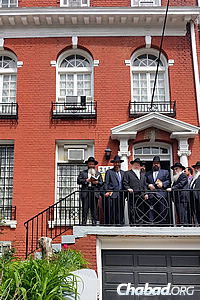
Outside the Embassy of Nepal.
Joining the meeting were also the highest-ranking members of Tzivos Hashem, the world’s foremost organization for Jewish children, founded by the Rebbe in 1981: Menachem Mendel Benjaminson, 11, of Morristown, N.J.; and Chaya Mushka Goldstein, 11, of Ann Arbor, Mich. They were both addressed by Obama as “general,” which is their rank in the corps. The president said he appreciated how they have achieved their high rank through many missions of learning and Jewish community service, as well as acts of kindness. As the delegation departed, a White House official remarked: “That was a profound meeting. I have been in many of these, and this one was really special.” 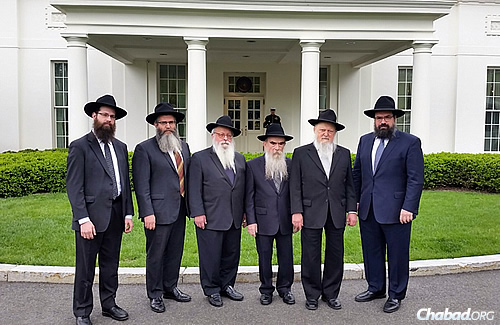
The delegation included, from left, Rabbi Meir Moscowitz; Rabbi Yossy Gordon; Rabbi Yisroel Shmotkin; Rabbi Abraham Shemtov; Rabbi Moshe Herson; and Rabbi Levi Shemtov.
The delegation recited the blessing typically made upon meeting a head of state and, in turn, gave the president a gift of a silver menorah, symbolizing light in the face of darkness and bearing an inscription that reads, in part: “Mr. President, you represent the middle flame, which stands on a higher plane, dedicated in service to others and the greater good, carrying the dreams and aspirations of an entire nation upon your shoulders.” “We were honored to be invited to the Oval Office to visit with the president, and delighted at how he was so engaged and sensitive to our discussion,” said Rabbi Levi Shemtov, executive vice president of American Friends of Lubavitch (Chabad). 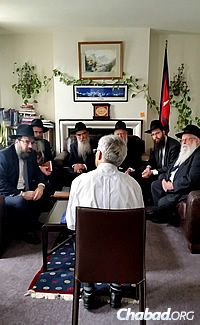
At the Embassy of Nepal with Charge d’Affaires Rishi Ram Ghimiri, offering support and assistance in light of the massive earthquake that claimed thousands of lives and devastated the capital city of Kathmandu.
The Charge d’Affaires—the new ambassador is due to arrive next week—at the embassy thanked them for their good wishes and prayers, reminding all of the wonderful relationship with the Nepalese people enjoyed by the Jewish community who live and visit there. Rabbi Chezky and Chani Lifshitz direct the Chabad House of Kathmandu and the Chabad House of Pokara in Nepal, which are frequented by thousands of tourists annually, including many Israeli backpackers and hikers. They also hold what is regarded to be the world’s largest Passover seder, which draws as many as 1,500 people a year. The international Chabad-Lubavitch movement is the world’s largest network of Jewish educational, social service and outreach organizations with more than 4,000 affiliates in 49 states and more than 80 countries. 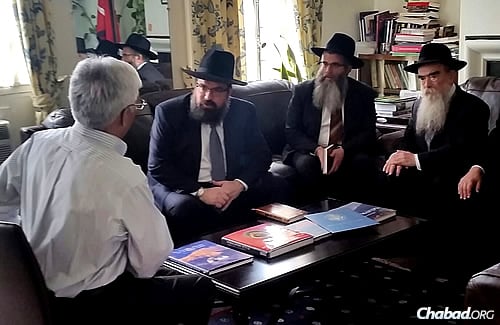
Just before heading to the White House yesterday, a delegation of Chabad-Lubavitch rabbis visited the Embassy of Nepal, which neighbors the Chabad center in Washington, D.C. There, they spoke with Charge d’Affaires Rishi Ram Ghimiri, offering support and assistance in light of the massive earthquake that claimed thousands of lives and devastated the capital of Kathmandu.
© Copyright 2015, all rights reserved.
| ||||||
Jewish News
| ||||||
Watch out! Watch this! Many clever lines will draw attention to the novelty of the upcoming Apple Watch, but right now, all eyes can turn to the first Jewish app for the new gadget, which will make the technology even handier for many users.
Released on Wednesday night, a much-anticipated Jewish app for the watch was launched by Chabad.org’s app team, bringing together the 3,000-year-old Jewish calendar with the hottest new item in technology these days: wearables. The first of its kind, the “Hayom” app (Hebrew for the word “today”) for the Apple Watch harnesses Apple’s latest product with Chabad.org’s extensive Torah knowledge. The amalgam of the two was a natural. After all, the observance of Judaism’s rituals revolves heavily around precise adherence to the clock: Make a blessing at this time, say a prayer at this time, stop working at this time and so forth. The new app tells time according to Jewish law, known as “halachic time,” which is governed by the movement of the sun. It also displays Hebrew dates, which are determined by a complex synthesis of the solar and lunar cycles. “The watch app reveals only some of the strategic planning that went into Chabad.org’s existing ‘Hayom’ app and other products,” explains Chabad.org’s lead app developer Dov Dukes. “We’re prepared for the latest developments in technology, including for wearables. Our app allows you to glance at your wrist and let you know right away what date it is on the Jewish calendar, and how much more time there is until the next halachicphase of the day.” 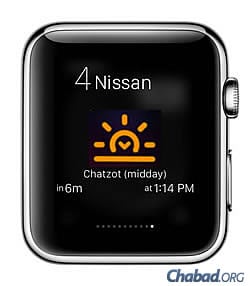
The new watch app works according to Jewish law, known as “halachic time.”
“The possibilities in app development for Jewish audiences keep expanding,” says Chabad.org’s managing director, Rabbi Meir Simcha Kogan, “and this step into wearable technology—to enable and assist with Jewish education and observance—is another important advance.” More Applications in the Works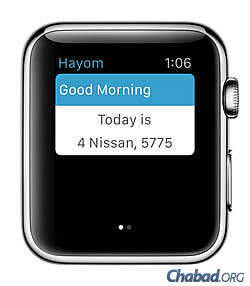
To make it all more personal, a greeting appears on the screen according to the time of day.
Other features of the Jewish app being considered include detecting when the wearer is strapping on tefillin and instantly pulling up the appropriate prayers on his smartphone; reminders to remove the watch in advance of Shabbat and Jewish holidays; and help tracking a user’s waiting time between eating meat and dairy meals. The “Hayom” watch extension joins Chabad.org’s Jewish Apps Suite in strategically leveraging Chabad.org’s content and know-how to make Jewish information and observance accessible on other platforms. 
Users of Chabad.org's Jewish watch app will get the added bonus of inspirational quotes.
Like the “Omer Counter,” the watch extension was made possible through the generosity of a group of funders. The drive, vision for and underwriting of the apps, which are available free of charge, come from the generous partnership of Dovid and Malkie Smetana, Alan and Lori Zekelman, the Meromim Fund, and Moris and Lillian Tabacinic—all dedicated to spreading the wisdom and practice of Judaism worldwide. The watch app joins the “Hayom” app, the “Passover Assistant,” the “Jewish.tv” video app, the “Shabbat Times” app, a JewishKids.org app for children, the “Omer Counter” and others—all designed to help bring Jewish wisdom and tools to the fingertips of users. Additional apps are in the planning and developmental stages by an international Chabad.org team. 
The new Jewish app will make wearables even more handy for many users. (Concept Image)

The “Hayom” watch extension joins Chabad.org’s Jewish Apps Suite in leveraging Chabad.org’s content and know-how to make Jewish information and observance accessible on other platforms. (Concept Image)
© Copyright 2015, all rights reserved.
| ||||||
Jewish News
| ||||||
When the French daily newspaper Le Parisien came out with its annual list of best high schools in the country, many people probably did a double take at the No. 1 ranked school—Beth Hanna, a Chabad-Lubavitch girls’ school in Paris.
Not surprised were members of the Jewish community who are familiar with the school, noting that it is a welcoming place that builds strong dedication to Jewish life and values, and has graduated many girls over the years. Among those who were pleased but not surprised is Rabbi Chaim Shneur Nisenbaum, who works at the preschool-through-grade 12 Complexe Scolaire Beth Haya Mouchka, which includes Beth Hanna. Three of the rabbi’s daughters have graduated from the high school and his wife, Yakuta, teaches Judaic subjects there. Remarking that the school has been highly rated for several years, Nisenbaum says “it’s very important that the Jewish school should rank high—not only on the media list, but also on the Ministry of Education list because the schools are chosen not for their Jewishness, but for their preparation for the national French exams.” “In France,” he continues, “the national exams and diplomas are central to the people and the culture, as they play a major role in ensuring the future of the students. It is particularly true of the Baccalauréat that students take upon finishing high school. The good results are a sign that the Jewish schools won the pedagogic battle on the general [education] field.” 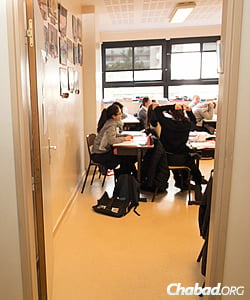
Beth Hanna rated well on multiple lists this year, based on grade-point averages, attendance rates and other significant factors. (Photo: Thierry Guez)
According to Le Parisien, what made the Beth Hanna a particular standout this year and led to the school receiving “added value” points—and thus, the stellar ranking—were a high proportion of matriculation exam-takers, grade-point averages, exceptional attendance rates and other significant factors. Nisenbaum credits the high school’s director, André Touboul, with the school’s academic success. “The school has remained faithful to the methods which have proved effective over the years,” explains the rabbi. “Furthermore, the fact that it is a fully Jewish school, with a Torah program during half of the day every day, gives the school a special atmosphere of work and respect, which eases the learning, and creates a close relationship between the students themselves and with their teachers.” 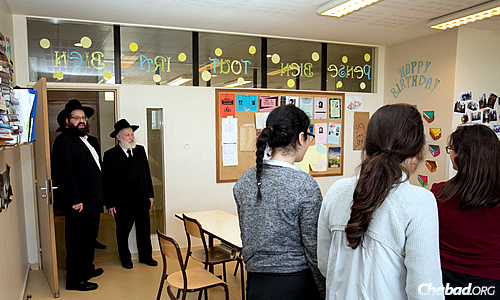
Rabbi Mendel Azimov, left, director of Beth Loubavitch Paris 16, and Rabbi Yehuda Krinsky, chairman of Merkos L’Inyonei Chinuch, the educational arm of the Chabad-Lubavitch movement, greet some students at the school. Rabbi Krinsky is currently in Paris for a conference with French shluchim. (Photo: Thierry Guez)
Future of the CommunityBeth Hanna is one of two Jewish schools that recently made nationally ranked educational listings in France; the other was the Lycée Alliance in the Paris suburb of Seine Saint-Denis, which was not on the newspaper list but on one compiled by France TV, the country’s public broadcast station. Another listing of schools was published by Le Figaro daily newspaper, with Beth Hanna coming in at No. 46 and the Alliance at No. 88.More than 4,000 schools are rated on these annual lists. This comes despite the fact that Jewish schoolchildren there have some added stress to their day. They now attend classes under armed guard due to a week of violence that occurred in Paris earlier this year—namely, the Jan. 9 terror attack at the Hyper Cacher kosher grocery, where four Jewish men were killed. That is no mere coincidence, says Nisenbaum. “The schools and their directors have an intense motivation. They know they have the future of the French Jewish community in their hands,” states the rabbi. “If the world outside looks less beautiful now, we have to magnify the inside that much more.” 
Chabad's École Chne-Or, the Shneor school in Aubervilliers, France, about 15 minutes north of Paris, also received recognition of late for its École Juive Pour Tous (“A Jewish School for All”) program. (Photo: Elie Haouzi)
© Copyright 2015, all rights reserved.
| ||||||
Story
| ||||||

Be holy. For I, Your G-d, am holy. (19:2)
"Be holy" - sanctify yourself also concernning what is permitted.
- The Talmud, Yevamos 20b.
The first thing we heard from the Rebbe (Rabbi Schneur Zalman of Liadi) upon our arrival in Li'ozna1 was: "What is forbidden, one must not; and what is permitted, one need not." Three or four years we toiled with this, until we made this approach part of our lives. Only then would we be received in a private audience ('yechidus') with the Rebbe to ask about our individual paths in serving the Almighty.
- Rabbi Mordechai of Horodok.
At a chassidic get-togethers (farbrengens) held in the early years of Chabad chassidism, Reb Shmuel Munkes was doing the honors. The merry chassid danced about the participants, pouring the vodka and serving the 'farbiesen' platters spread with bites of food to follow up the l'chayims.
Among the dishes which had arrived from the kitchen of Reb Nosson the shochet2 was a bowl of roasted lung, a most tasty delicacy. But for some reason, Reb Shmuel was reluctant to part with this particular dish. Throughout the evening he pranced about, pouring the l'chayims and serving the food, with the bowl of roasted lung snug and elusive under his arm, deftly side-stepping all attempts to free it from his grasp.
Soon the chassidim grew weary of Reb Shmuel's game and demanded outright that he hand over the bowl and its mouth-watering contents. But the waiting chassid ignored their angry demands and kept up his dodging dance. Finally, a few of the younger chassidim decided that Reb Shmuel's prank had gone on long enough. They rose from the table, and soon the bowl and its bearer were cornered. But with a final leap and twist, Reb Shmuel dumped the roasted lung into the spittoon, and broke out in a merry k'zatzkehdance.
The younger chassidim sat to consider the gravity of Reb Shmuel's crime and decreed that a few well placed stripes were in order. Without batting an eye, Reb Shmuel stretched himself out on the table and received his due. He then set out in search of more farbiesento keep the farbrengengoing. But the hour was late, and the best he could come up with was a plate of pickled cabbage donated by one of the Li'ozna residents.
Upon seeing the replacement dish, the expressions on the faces of those who had already imagined the taste of roasted lung grew as sour as the krautset before them. But soon a commotion was heard in the hallway. The town's butcher ran in, a most stricken look on his face: "Jews! Don't eat the lung!" he cried. "There has been a terrible mistake." It seems that the butcher was out of town and the butcher's wife mistakenly gave the shochet's wife a non-kosher lung to roast for the farbrengen.
Now it was the elder chassidim who sat in judgement upon Reb Shmuel. The audacity of a chassid to play the wonder-rabbi! By what rights had Reb Shmuel taken it upon himself to work miracles? Up onto the table with you, Reb Shmuel, decreed the court.
After receiving his due for the second time that night, Reb Shmuel explained: "G-d forbid, I had no inside information regarding the roasted lung. But when I entered into yechiduswith the Rebbe for the first time, I resolved that no material desire would ever dictate to me. So I trained myself not to allow anything physical to overly attract me.
"When the bowl of roasted lung arrived, I found that my appetite was most powerfully roused. I also noticed that the same was true of many around the table. To be so strongly drawn by a mere piece of meat? I understood that something was not right."
When the Czar's soldiers came to arrest Rabbi Schneur Zalman in 1798, the Rebbe consulted with Rabbi Shmuel Munkes: should he go into hiding or allow himself to be taken to Petersburg? Reb Shmuel advised his Rebbe not to resist. "Why?" asked Rabbi Schneur Zalman. Answered Reb Shmuel: "One or the other. If you are truly a Rebbe, then no harm will befall you. And if you are not - you deserve it! How dared you deprive thousands of Jews of their pleasure in the material world?"
Yanki Tauber is content editor of Chabad.org.
© Copyright 2015, all rights reserved.
| ||||||
Lifestyle
| ||||||
The festive day of Lag BaOmer is approaching, when many people make bonfires and barbecues. Kebabs are delicious fresh off the grill, but you can easily make them in the oven on a regular week night.
 Best of all, they only take 12 minutes in the oven and you can prepare them in advance. So if you know you'll be coming home late and rushing to get dinner on the table, prepare these ready the night before, line them up on a cookie sheet and cover with foil. As soon as you get home, heat the oven and you can have them ready and on the table in a flash.  If you'll be grilling, soak the skewers in water for 30 minutes before using. This will prevent them from catching fire. You can play around with the vegetables. Peppers, olives and mushrooms all work well too. Or if you prefer meat, try this recipe.  Serve alone, or with rice, mashed potatoes or couscous. Or if you're barbecuing, throw some corn on the grill–it's delicious. Leftovers taste good either cold or reheated and make a delicious and convenient take-to-work lunch. For a gluten free version, use gluten-free soy sauce or an alternative.  Ingredients
Marinade Ingredients
Directions

Miriam Szokovski is the author of historical novel Exiled Down Under, and a member of the Chabad.org editorial team. She enjoys tinkering with recipes, and teaches cooking classes to young children. Miriam shares her love of cooking, baking and food photography on Chabad.org’s food blog, Cook It Kosher and in the N'shei Chabad Newsletter.
© Copyright 2015, all rights reserved.
| ||||||
Chabad.org Magazine - Editor: Yanki Tauber

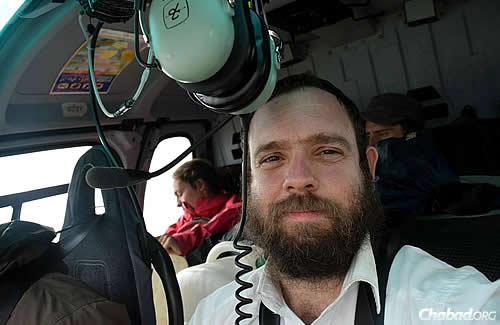
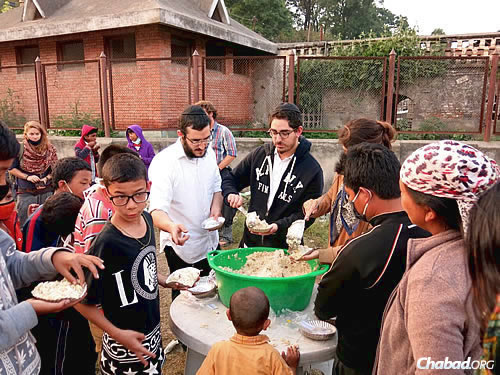
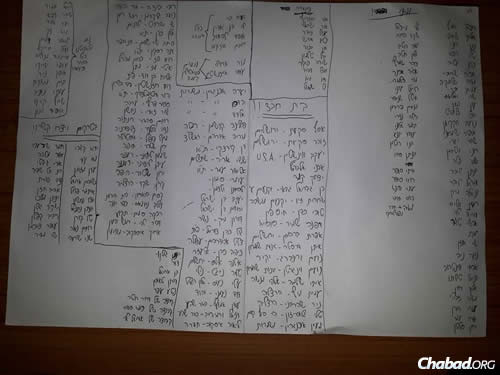
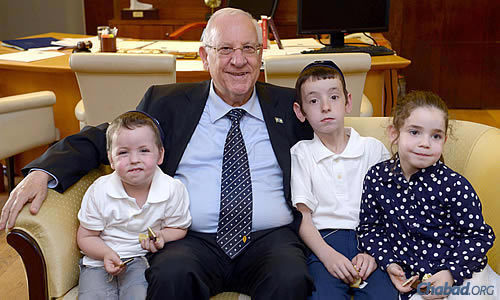

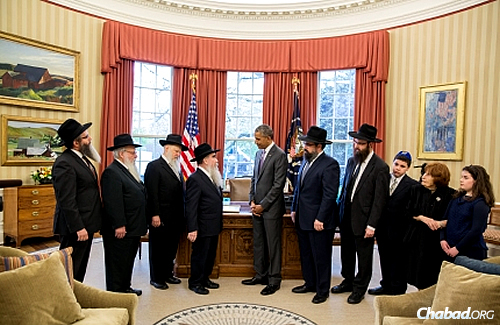

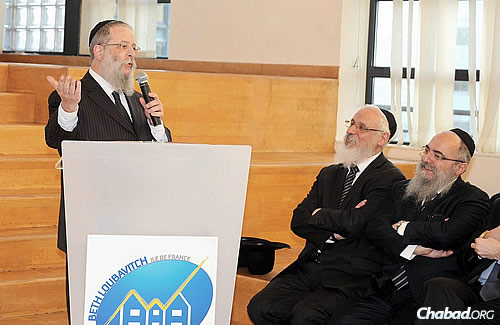
No comments:
Post a Comment